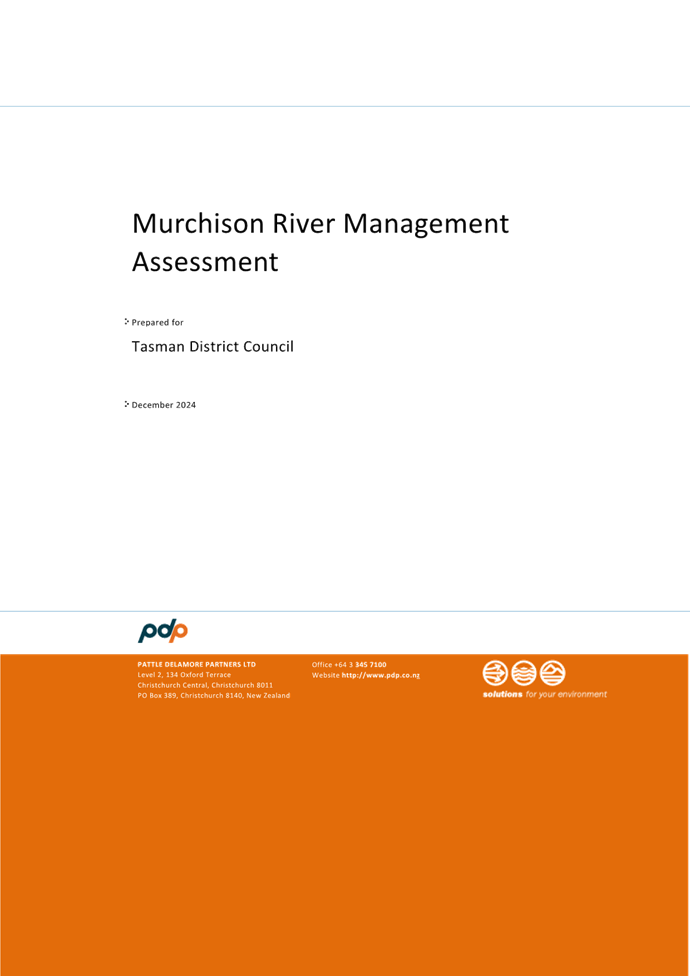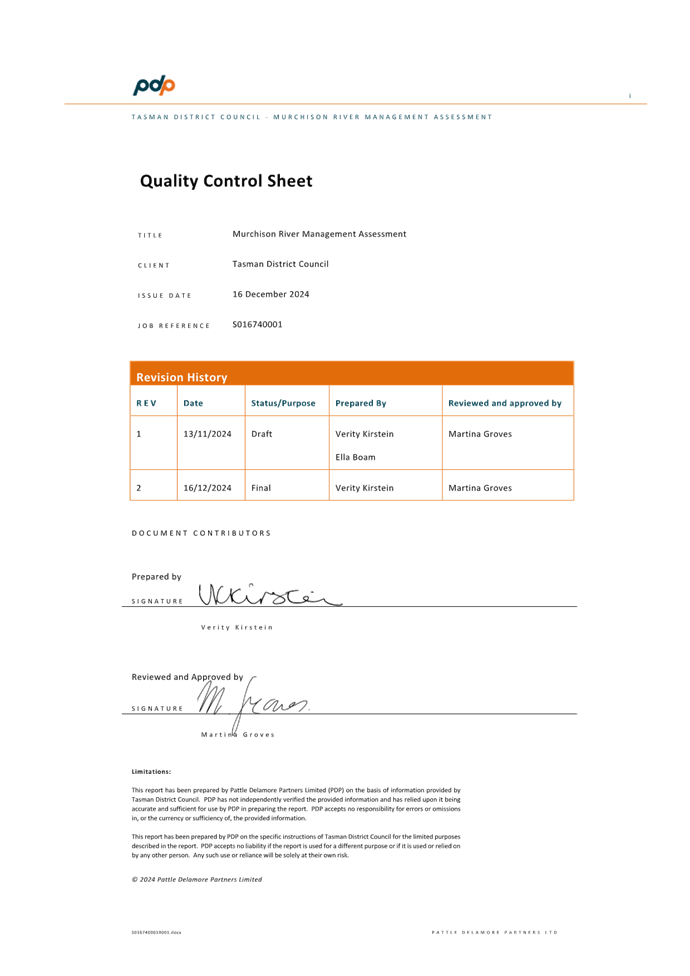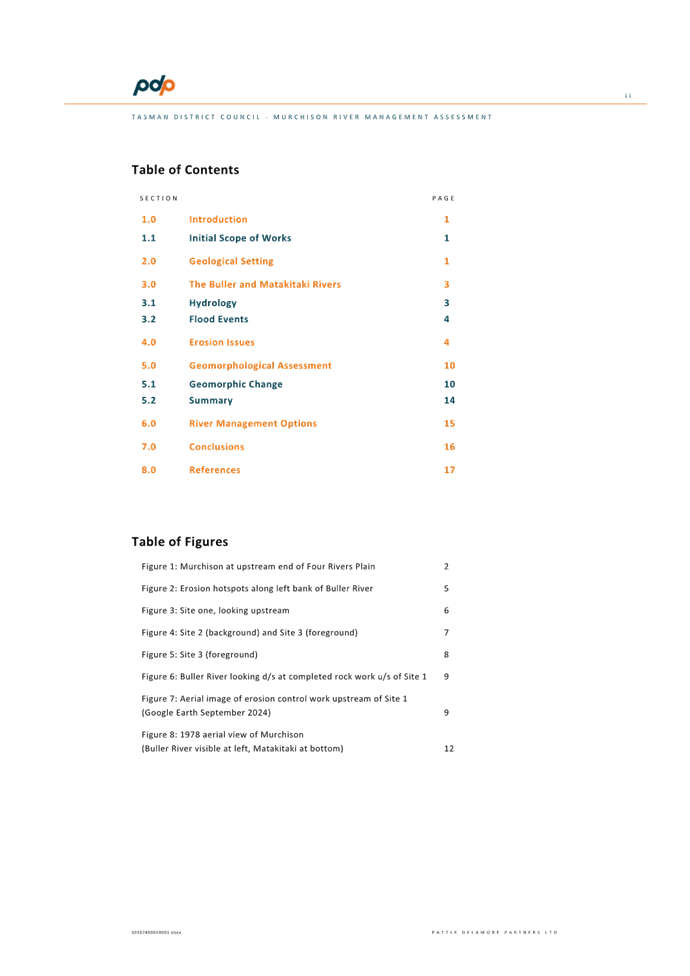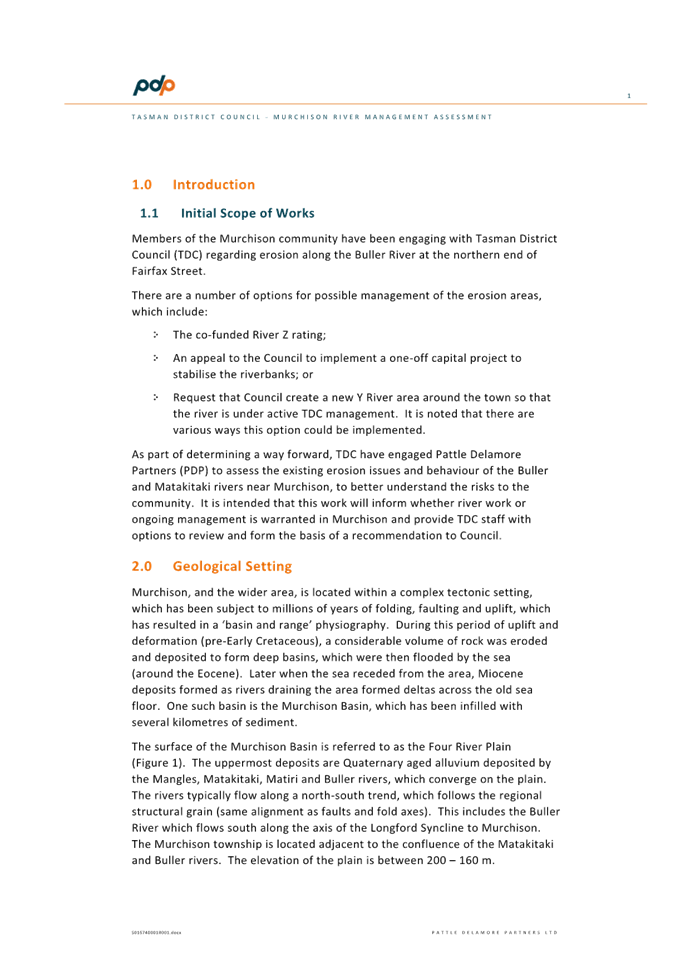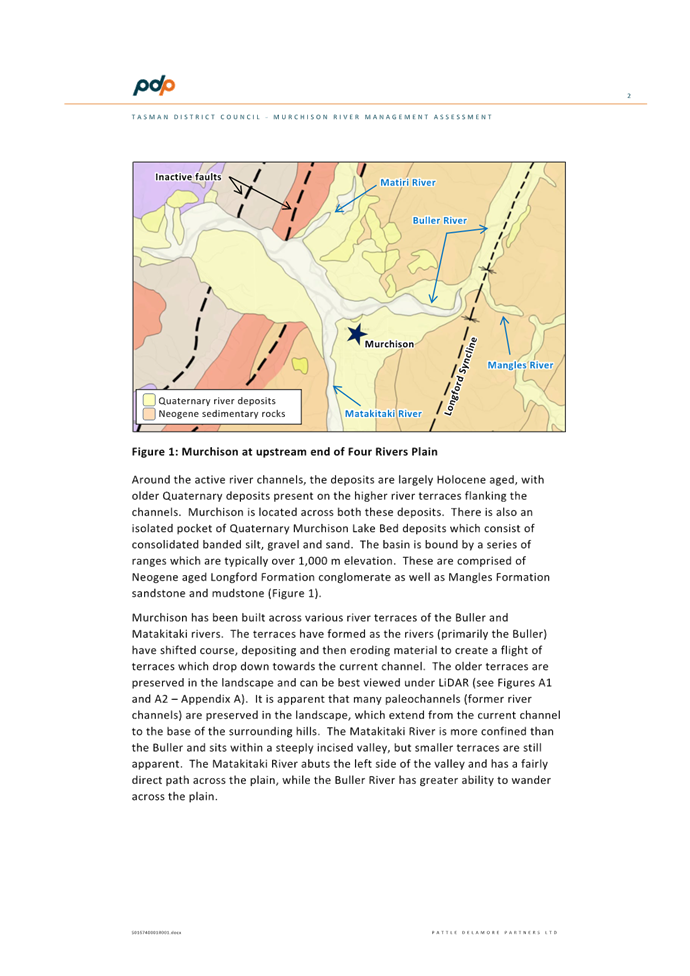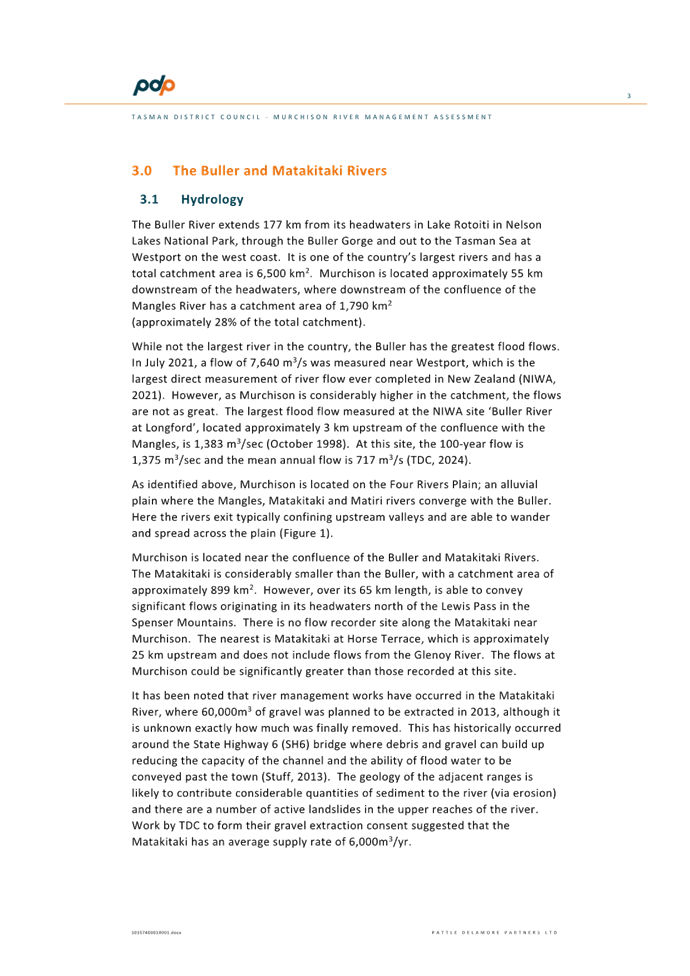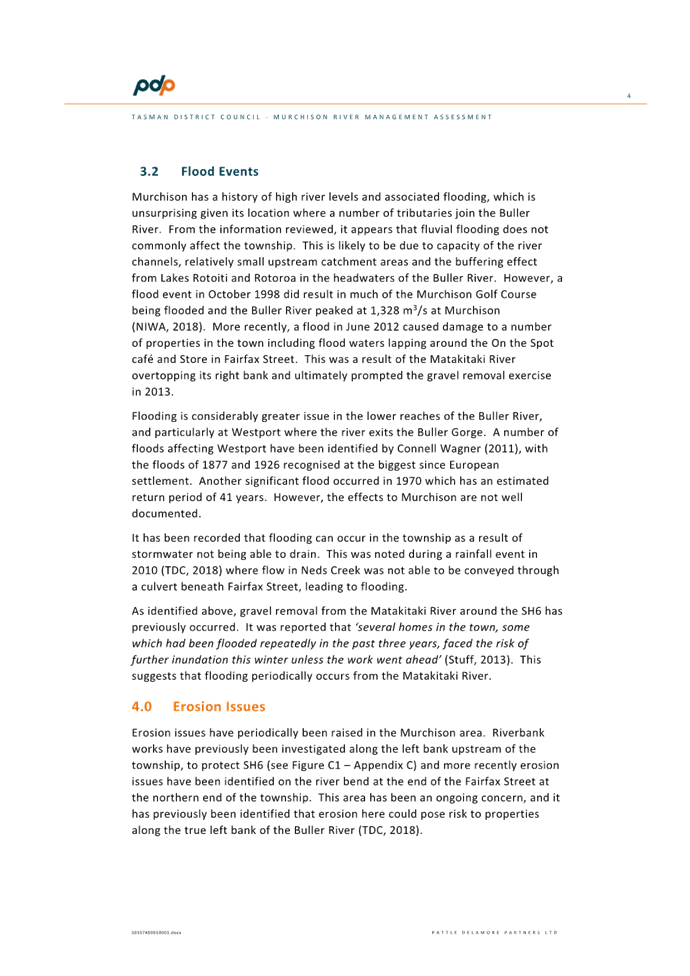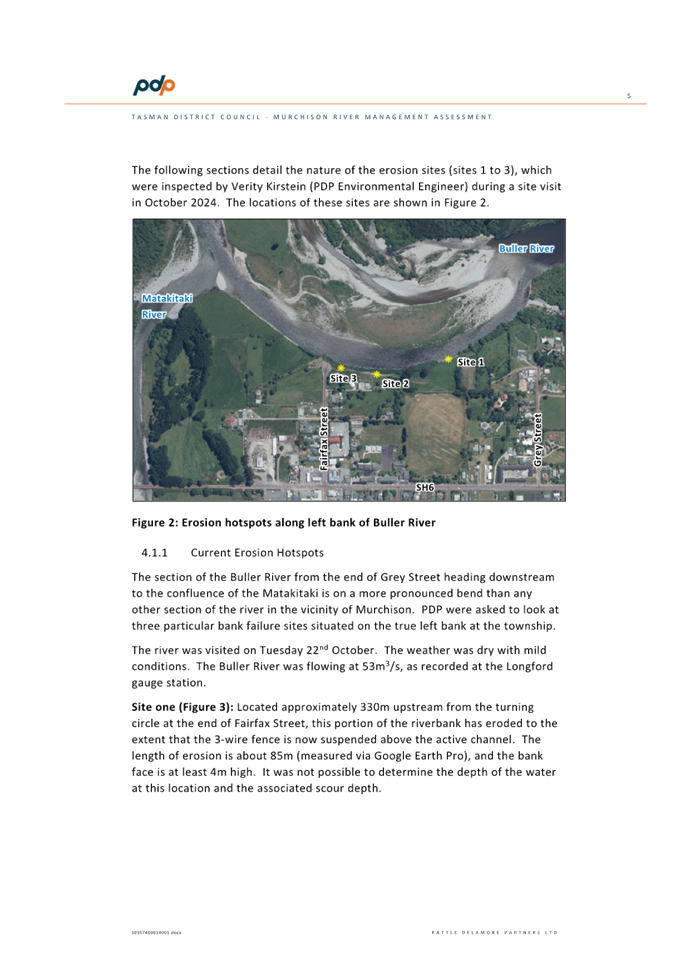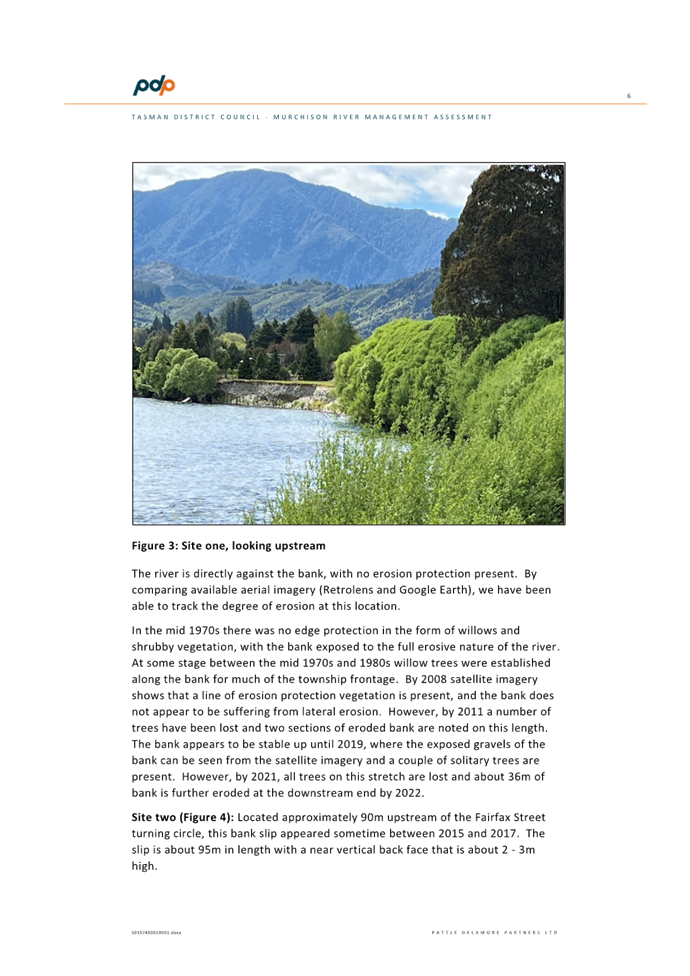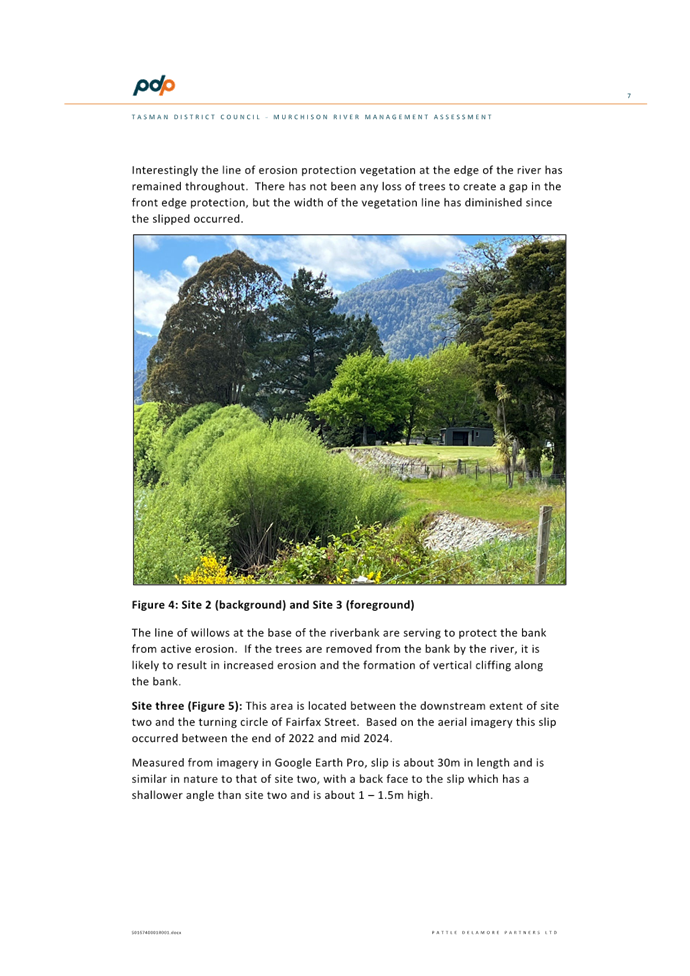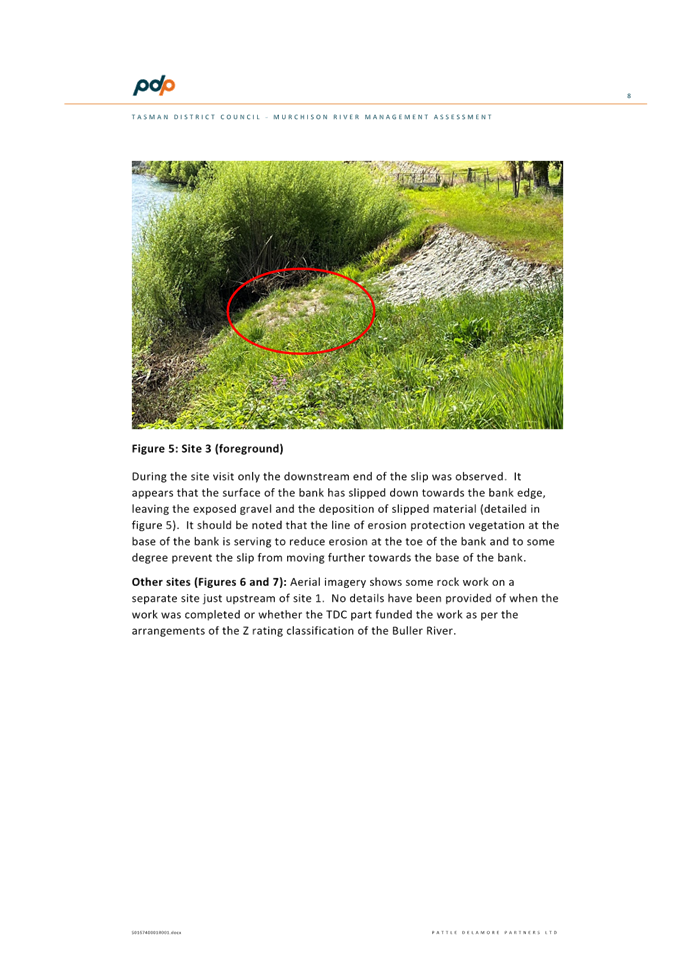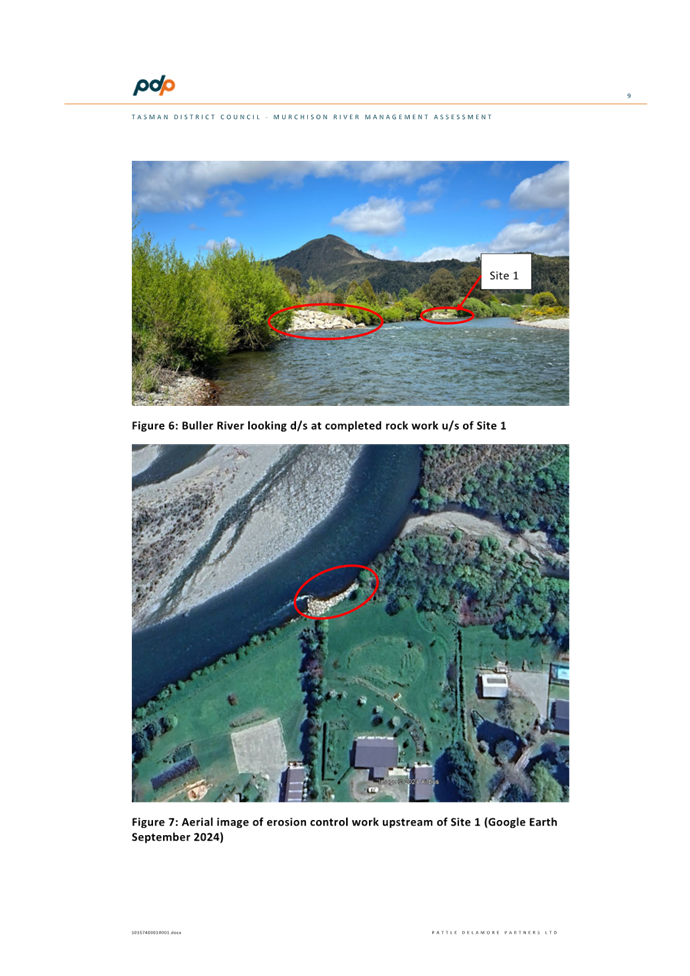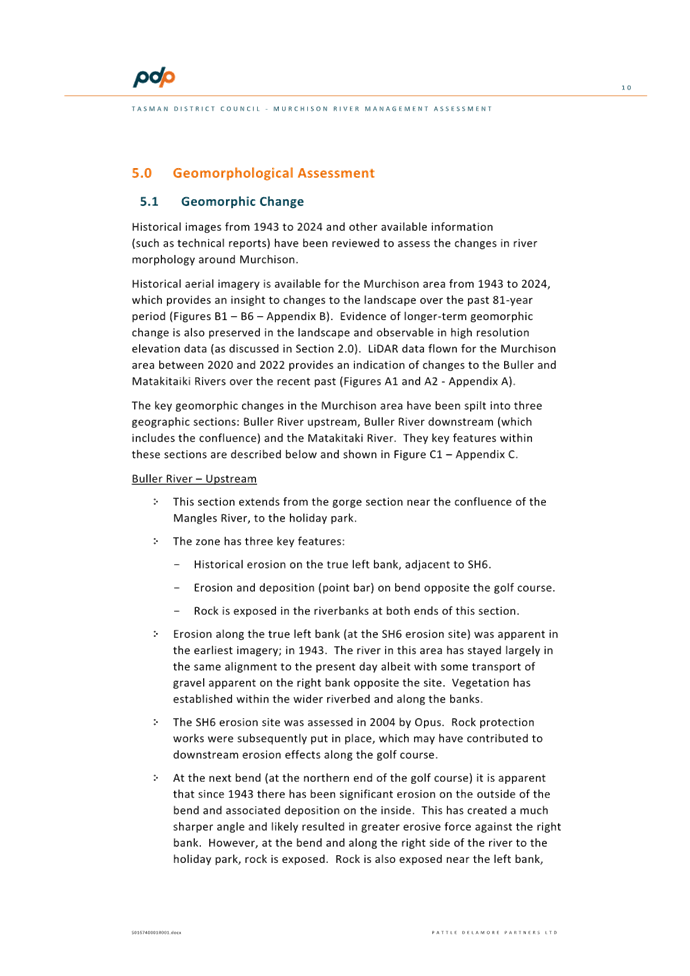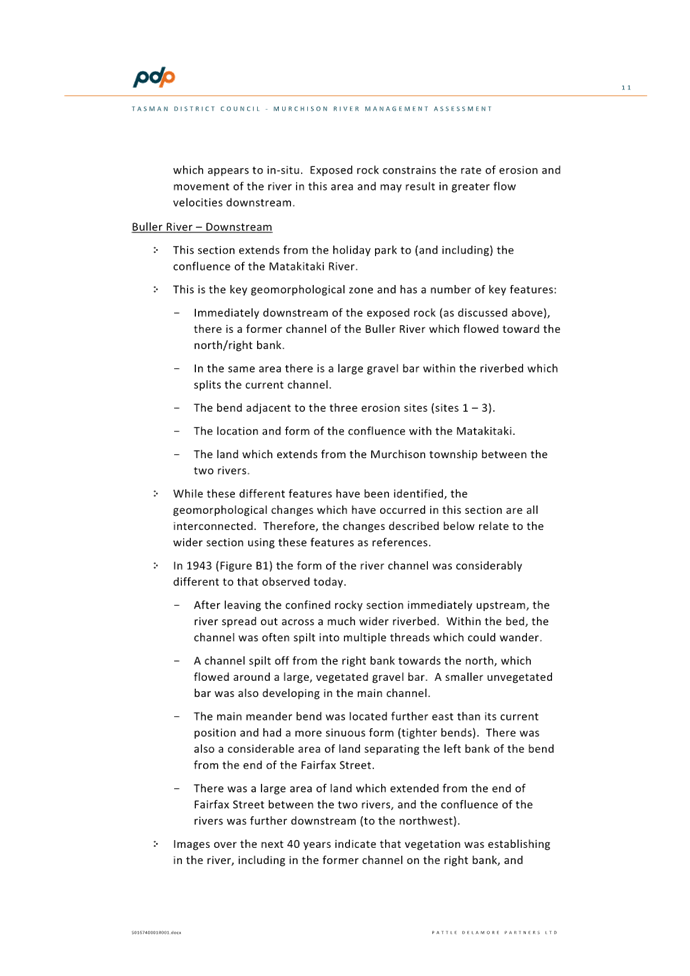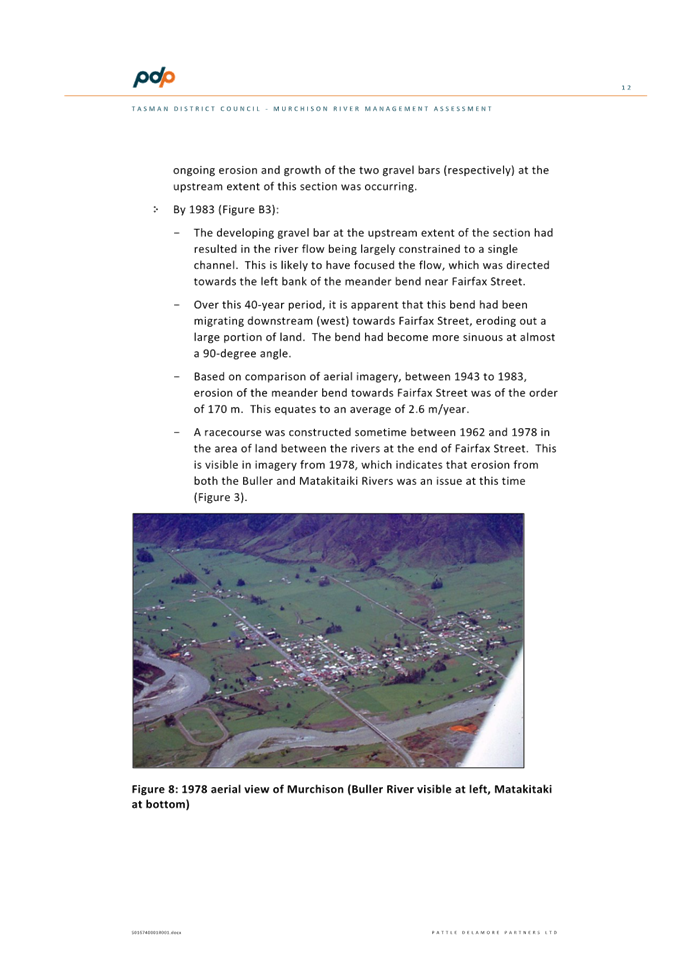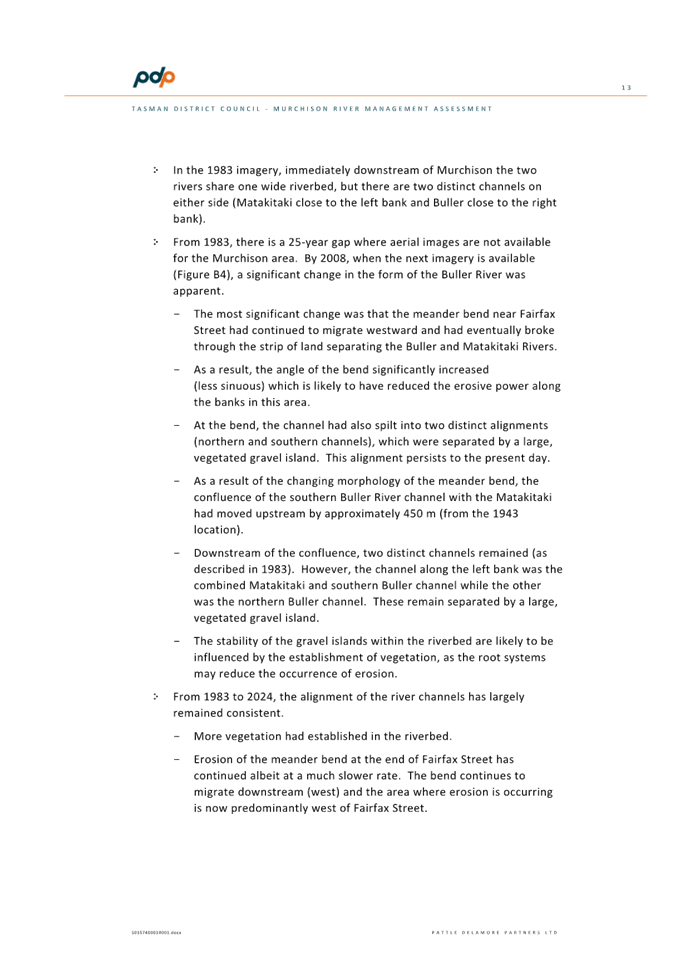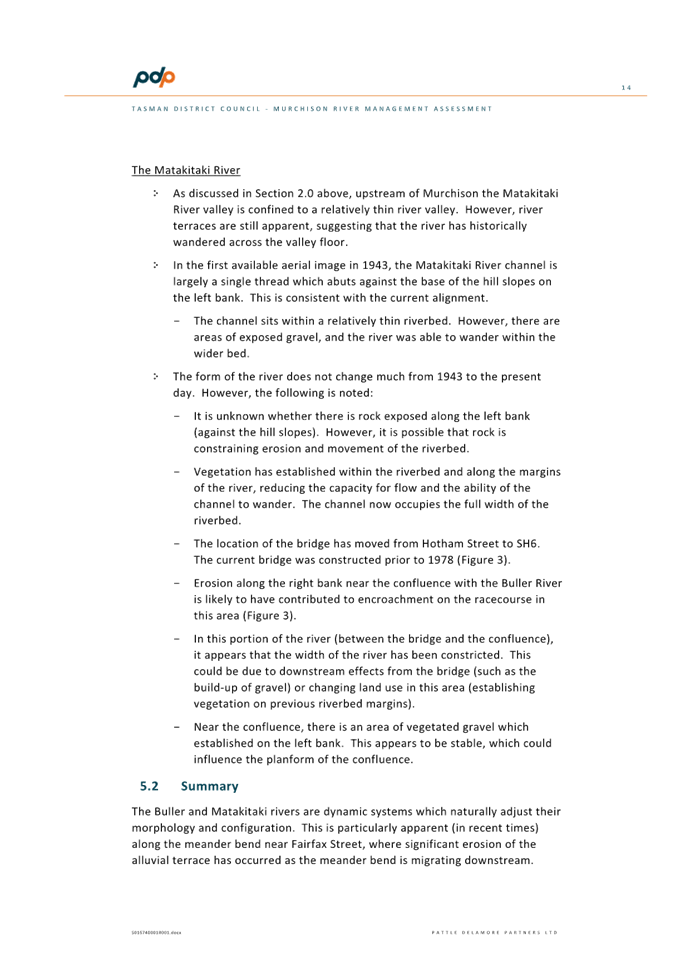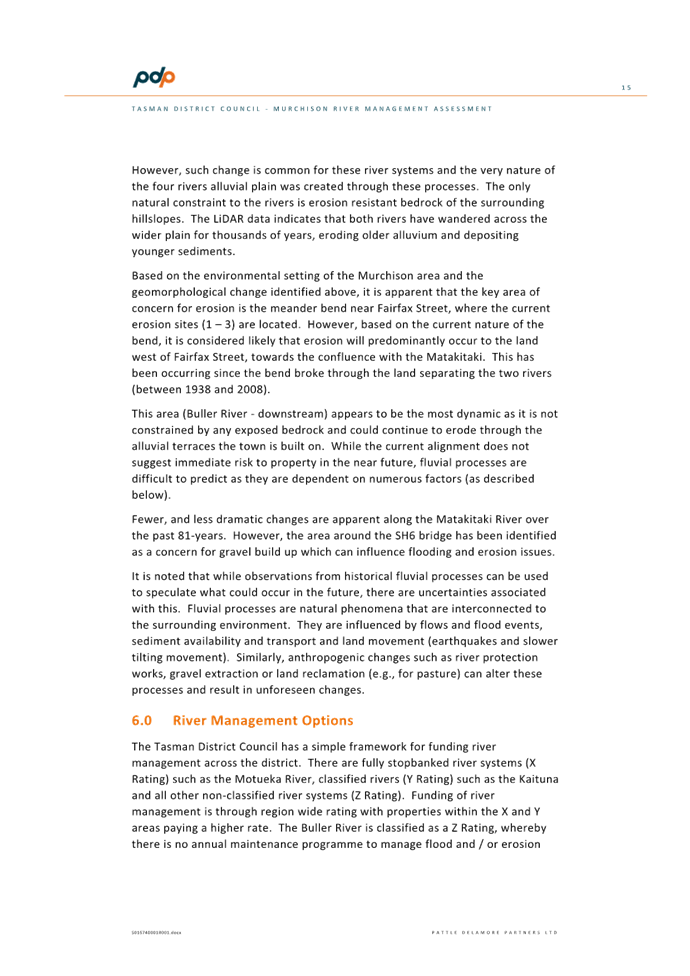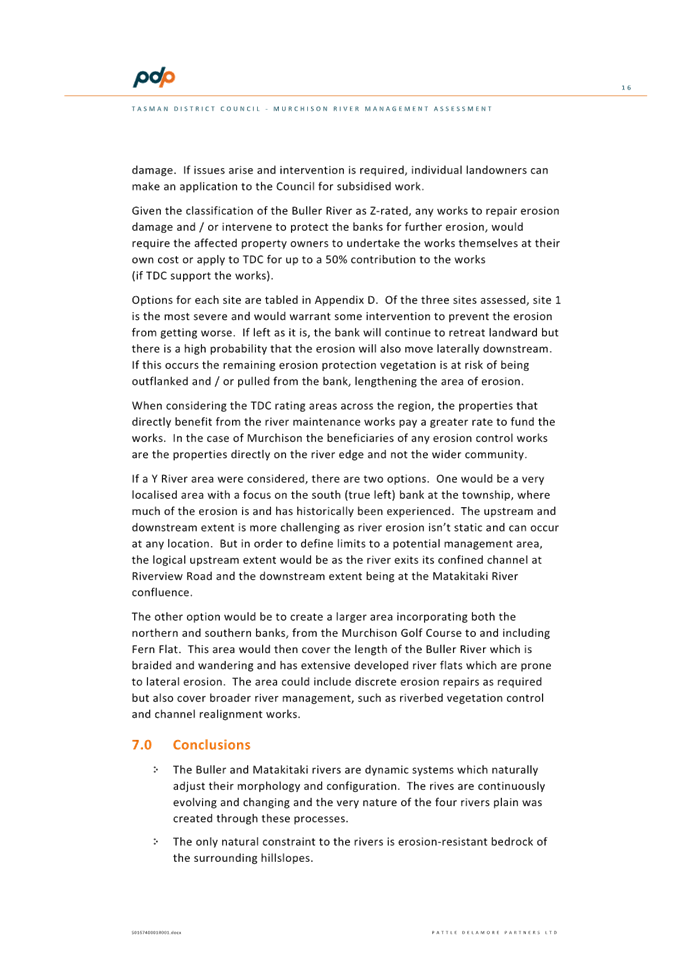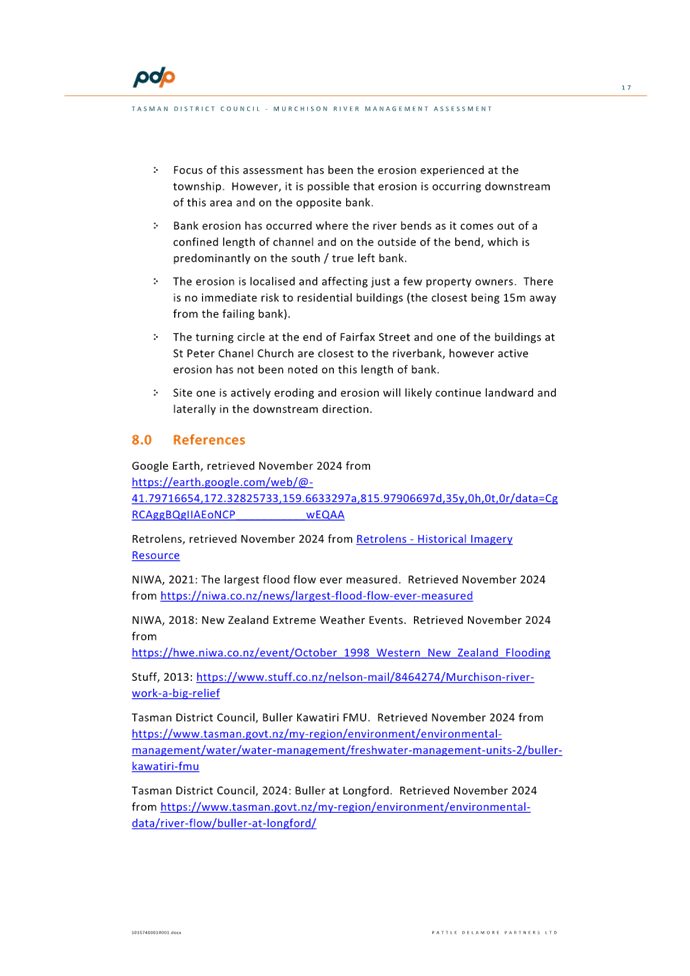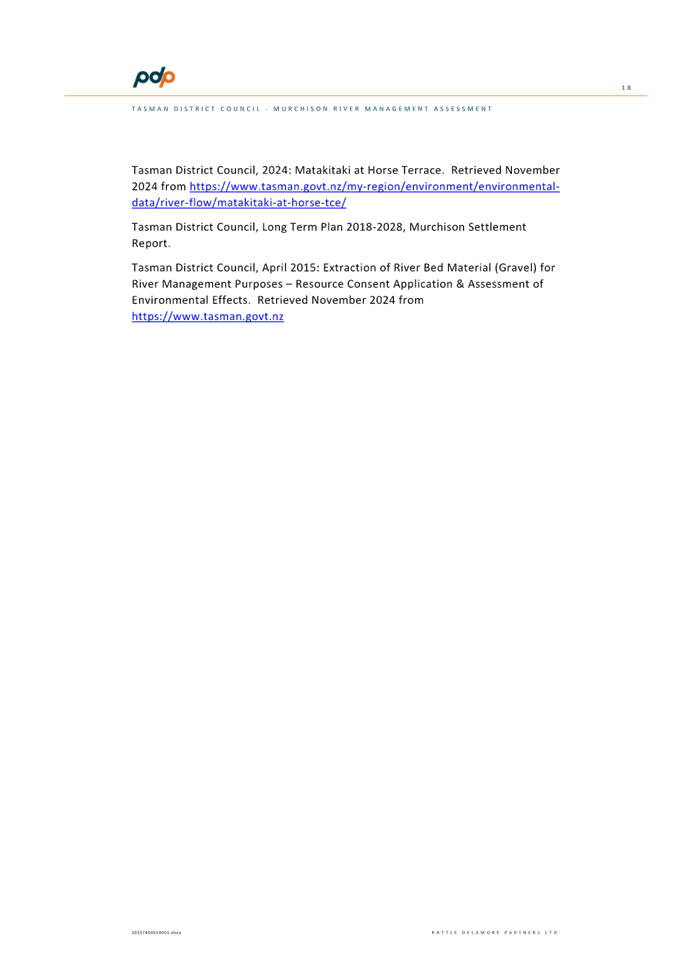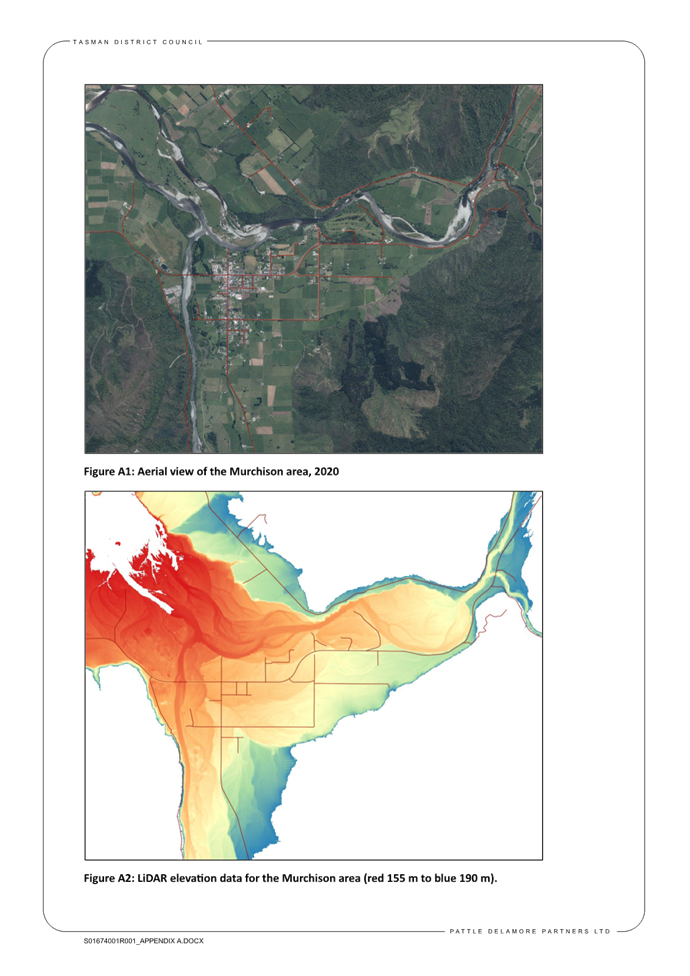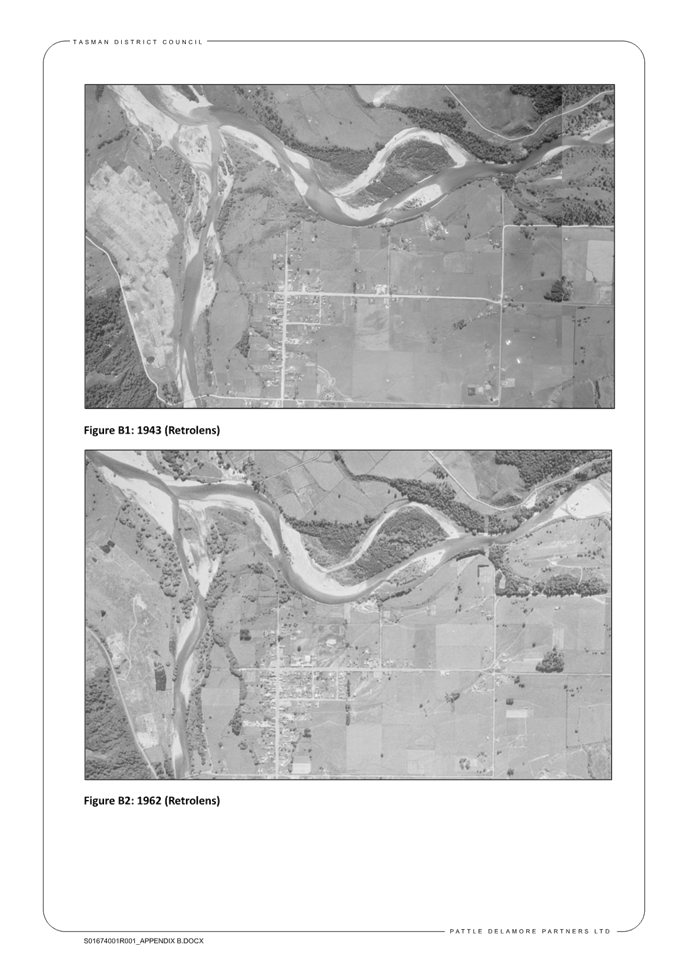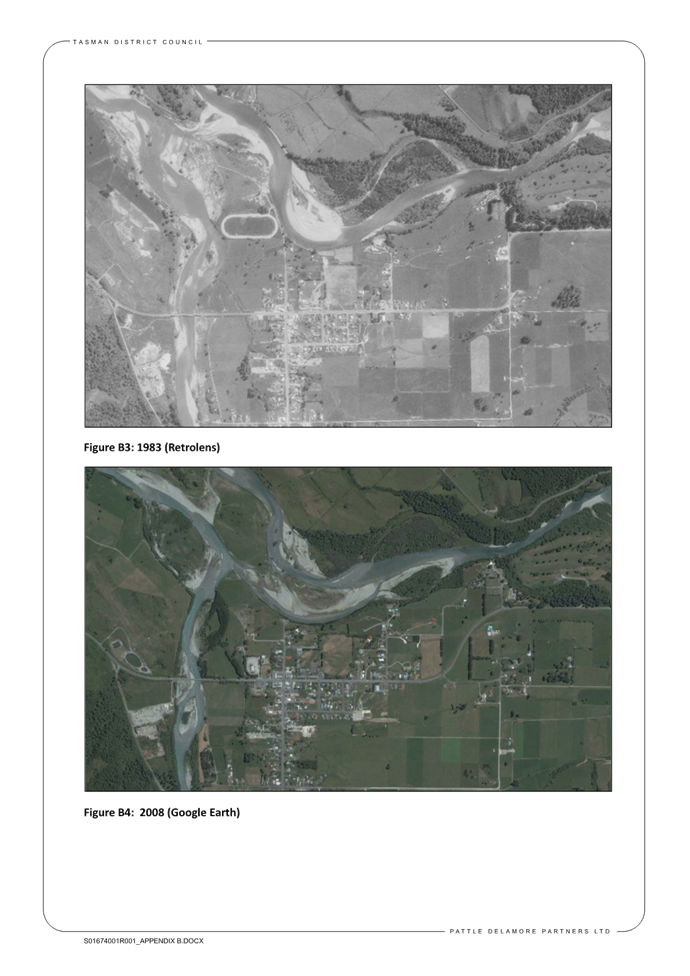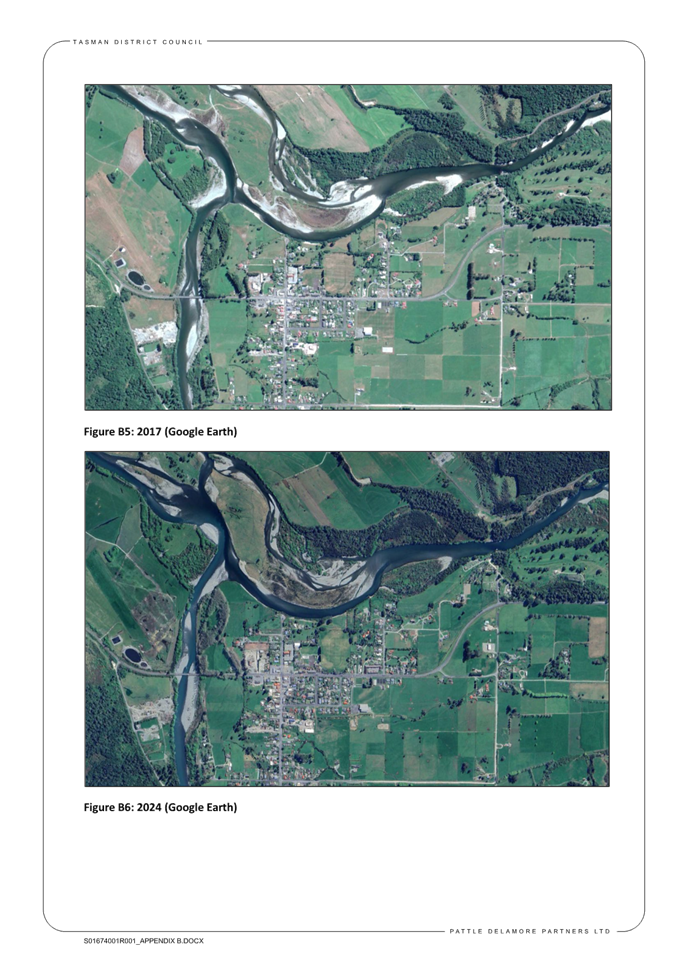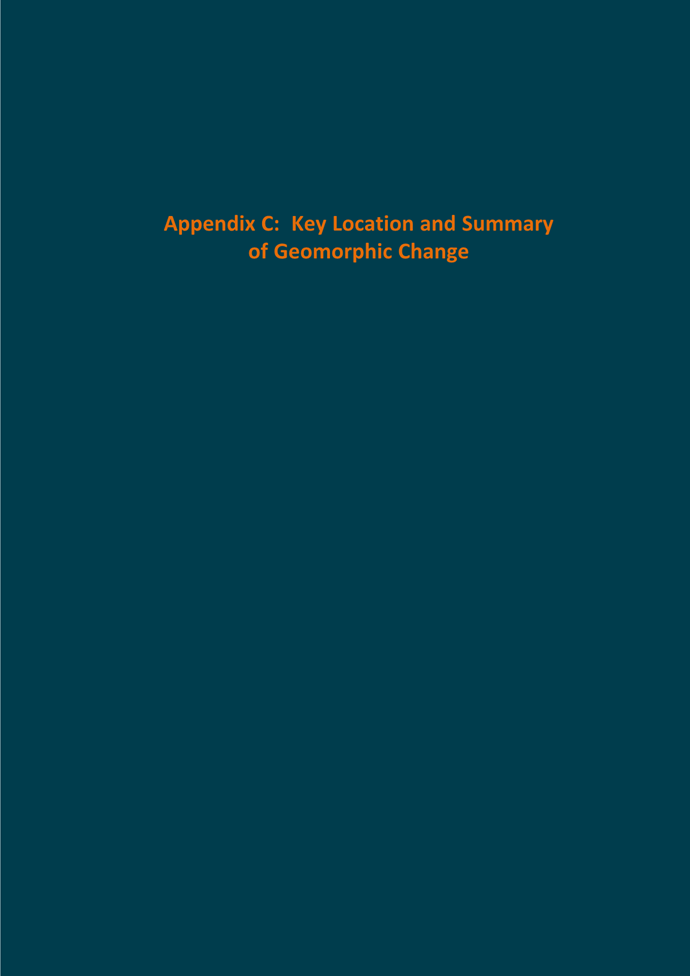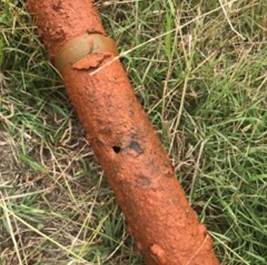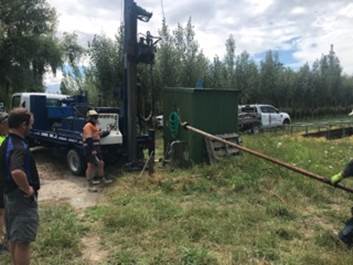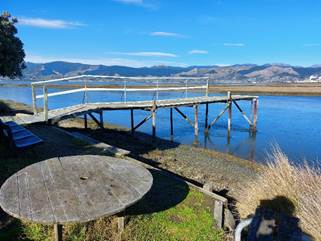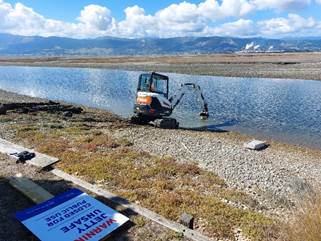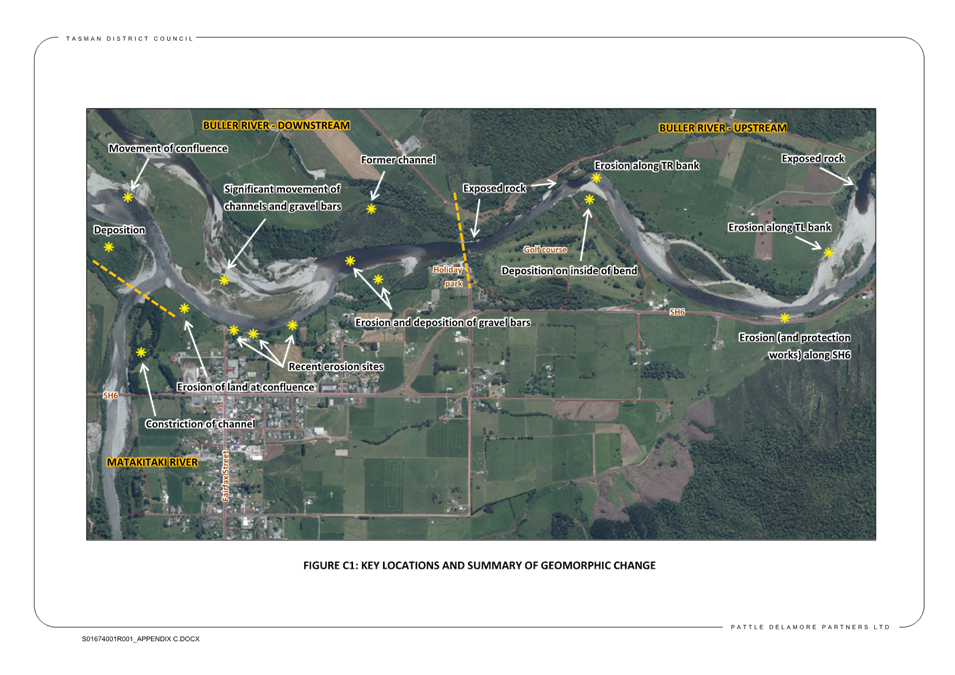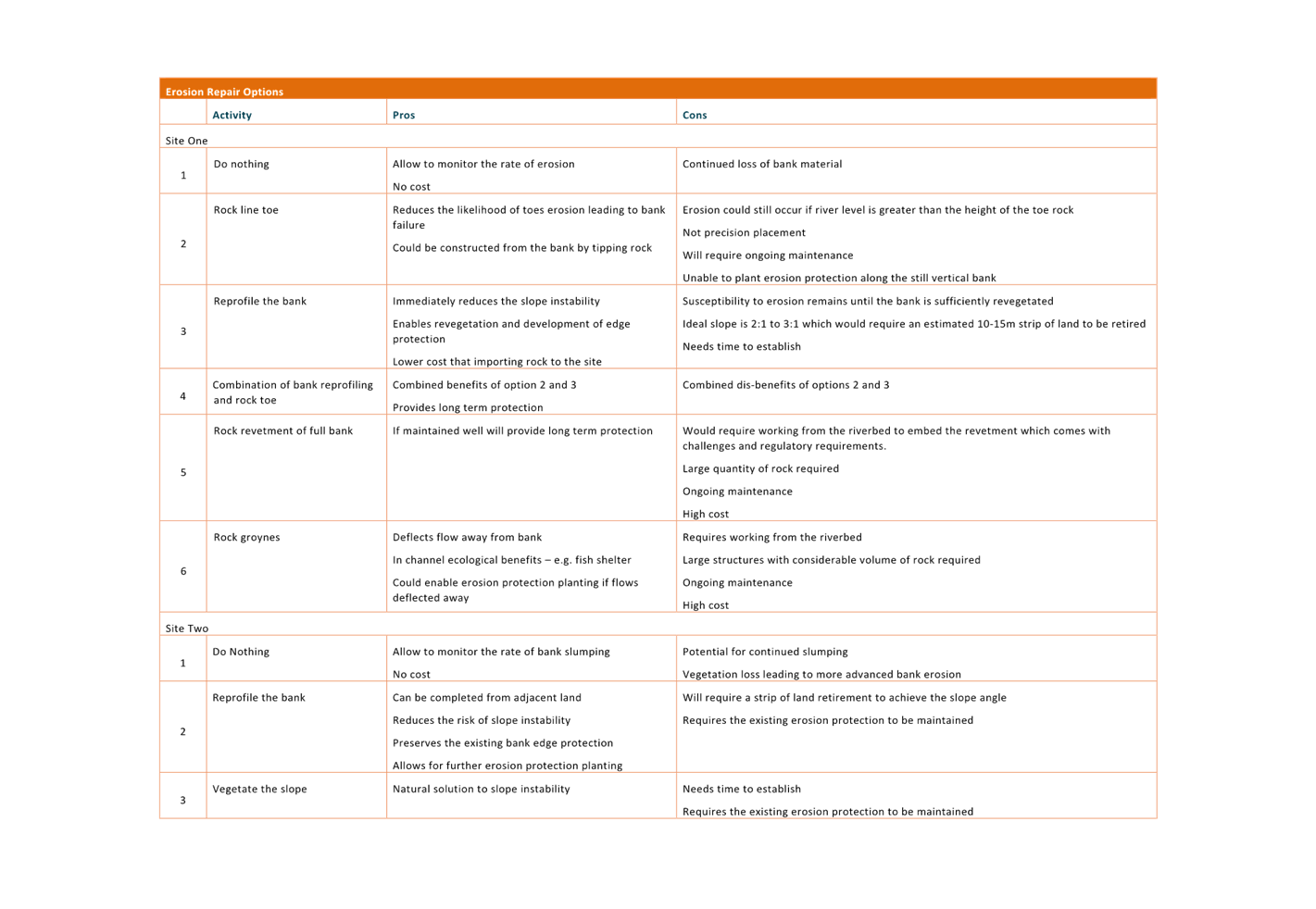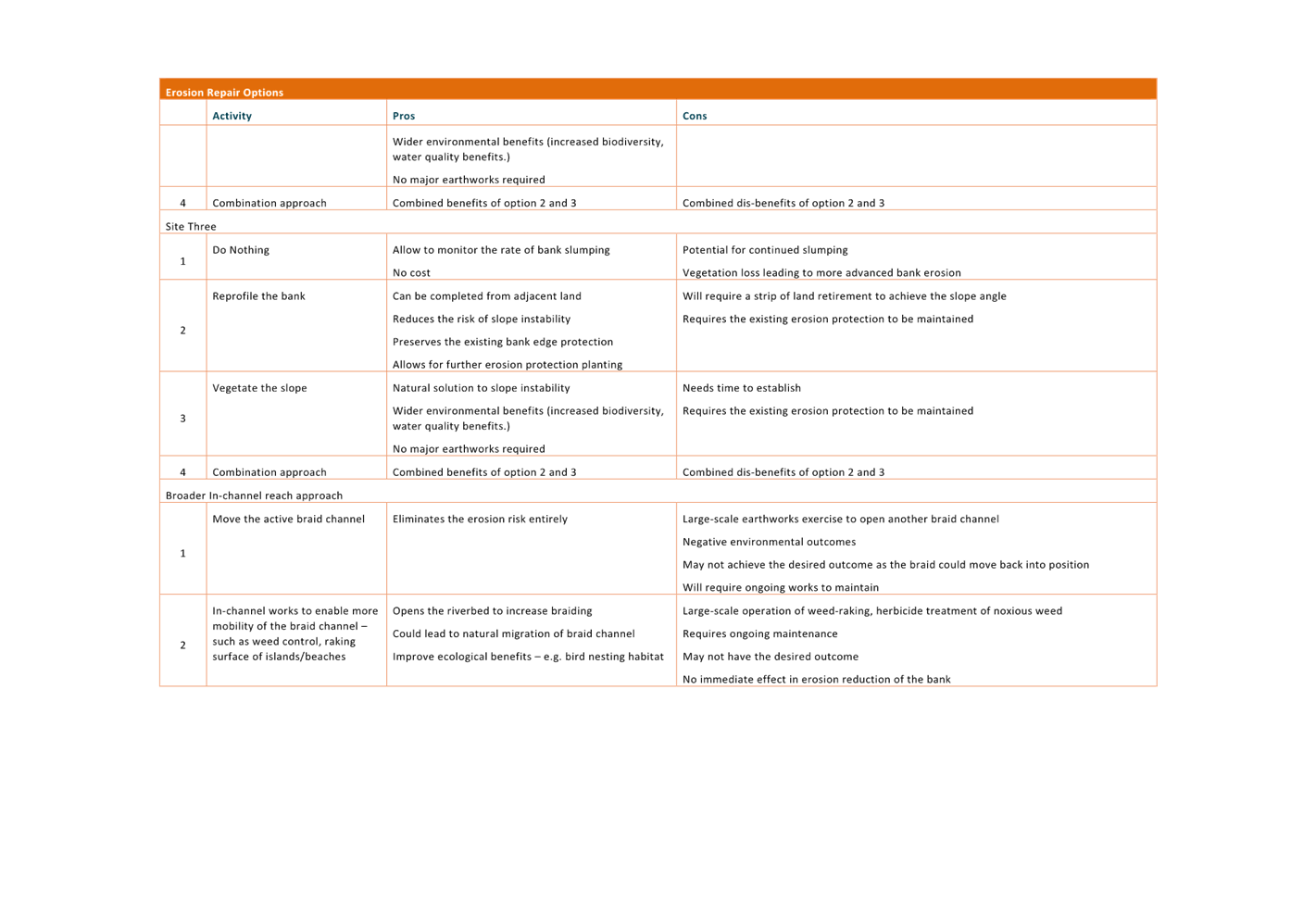Notice is given that
an ordinary meeting of the Environment and Regulatory Committee will be held
on:
MEMBERSHIP
|
Chairperson
|
Cr C Hill
|
|
|
Deputy Chairperson
|
Cr B Maru
|
|
|
Members
|
Mayor T King
|
Cr M Greening
|
|
|
Deputy Mayor S Bryant
|
Cr C Mackenzie
|
|
|
Cr C Butler
|
Cr M Kininmonth
|
|
|
Cr G Daikee
|
Cr K Maling
|
|
|
Cr B Dowler
|
Cr D Shallcrass
|
|
|
Cr J Ellis
|
Cr T Walker
|
(Quorum 7
members)
|
|
|
Contact
Telephone: 03 543 8400
Email:
tdc.governance@tasman.govt.nz
Website: www.tasman.govt.nz
|
Environment and
Regulatory Committee Agenda – 11 March 2025
AGENDA
1 Opening, Welcome, KARAKIA
2 Apologies
and Leave of Absence
|
Recommendation
That the
apologies be accepted.
|
3 Public
Forum
Nil
4 Declarations
of Interest
5 LATE
ITEMS
6 Confirmation
of minutes
|
That the minutes of the Environment
and Regulatory Committee meeting held on Thursday, 21 November 2024, be confirmed
as a true and correct record of the meeting.
|
7 Reports
7.1 Resource
Management (Consenting and Other System Changes) Amendment Bill 4
7.2 Water
Services Bill Submission............................................................................. 29
7.3 Group
Manager's Report....................................................................................... 45
7.4 Building
Assurance Manager's Report.................................................................. 53
7.5 Resource
Consents Manager's Report................................................................. 63
7.6 Rivers
and Coastal Structures............................................................................... 77
8 Confidential
Session
Nil
9 CLOSING
KARAKIA
Environment and
Regulatory Committee Agenda – 11 March 2025
7 Reports
7.1
Resource
Management (Consenting and Other System Changes) Amendment Bill
Decision Required
|
Report
To:
|
Environment
and Regulatory Committee
|
|
Meeting
Date:
|
11
March 2025
|
|
Report
Author:
|
Charlotte
Sunde, Policy Planner - Natural Resources
|
|
Report
Authorisers:
|
Barry
Johnson, Environmental Policy Manager; Kim Drummond, Group Manager -
Environmental Assurance
|
|
Report
Number:
|
RRC25-03-1
|
1. Purpose
of the Report / Te Take mō te Pūrongo
1.1 To
retrospectively approve Tasman District Council’s submission on the
Resource Management (Consenting and Other System Changes) Amendment Bill.
1.2 This
submission, signed by the Mayor, was submitted on 10 February 2025 under
delegated authority on behalf of the Council. Staff now seek retrospective
approval of this submission.
2. Recommendation/s
/ Ngā Tūtohunga
That the Tasman District Council
1. receives
the Resource Management (Consenting and Other System Changes) Amendment Bill
report RRC25-03-1; and
2. retrospectively
approves the Council’s submission on the Resource Management (Consenting
and Other System Changes) Amendment Bill (Attachment 1 to the agenda report).
3.1 In
January, Council staff prepared a submission for the Resource Management
(Consenting and Other System Changes) Amendment Bill. It was submitted to
Parliament’s Environment Committee on 10 February 2025.
3.2 Tasman’s
submission was informed by submissions from the local government sector groups,
Te Uru Kahika and Taituarā. In general, Tasman’s submission
supported their positions on the Bill.
3.3 This
is the second Resource Management Act (RMA) Amendment Bill introduced by the
coalition Government as part of Phase 2 of the resource management reform
process. Phase 1 saw the repeal of the Natural and Built Environment Act 2023
and Spatial Planning Act 2023, in December 2024. Phase 2 comprises targeted
amendments to the RMA. Phase 3 will include a package of changes to
national planning documents (e.g., National Policy Statements, National
Environmental Standards and other Resource Management Regulations) and the
proposed replacement of the RMA 1991.
3.4 The
Resource Management (Consenting and Other System Changes) Amendment Bill
proposes changes across a range of RMA matters, affecting compliance,
monitoring and enforcement; consents; management of discharges; natural hazards
and emergency works; farming and the primary sector; rules that control
fishing; fees, rents and royalties; as well as introducing new ministerial
powers.
3.5 Tasman’s
submission outlined concerns with some proposed changes, including:
3.5.1 New
and heightened ministerial intervention powers, enabling the Minister to direct
councils to prepare a plan change to give effect to a National Policy Statement
(NPS). Tasman’s submission pointed out that there may be valid reasons
why council has not given effect to national direction, and that ministers should
be fully informed of council circumstances before exercising such intervention
powers.
3.5.2 Removal
of the applicant or submitters’ ability to request a hearing:
Tasman’s submission opposed this proposed change and recommended that it
be delayed to the full RMA review. Opposition to this proposed amendment has
been widespread from local authorities and consent holders including the
electricity generation sector.
3.6 Tasman’s
submission also recommended additional amendments be included in the Bill,
regarding:
3.6.1 Use
of the freshwater planning process: Tasman recommended an amendment to
section 42 of the RMA enabling ministerial approval for councils to not
use the freshwater planning process, allowing councils to undertake their own hearings for freshwater plan changes
that are not related to the National Policy Statement for Freshwater Management.
3.6.2 Use
of the streamlined planning process: Tasman welcomed the application of this
process and requested extending its scope to housing and business plan changes
that provide for urban growth identified in a current Future Development
Strategy.
3.7 Tasman
differed from the position taken in the submission of Te Uru Kahika on rules
that control fishing. Tasman’s position is that council does not wish to
engage in fisheries management and that costs associated with those
responsibilities rightfully sit with the Minister of Fisheries and be funded by
taxpayers.
3.8 Overall,
Tasman’s submission supports many of the changes proposed through the
Bill that aim at improving aspects of the current system that are overly
cumbersome and complex. Where Tasman staff have identified opportunities for
improvements, the submission has suggested specific wording or deletions to the
proposed clauses.
4. Analysis
and Advice / Tātaritanga me ngā tohutohu
4.1 In
drafting Tasman’s submission, council staff from Environmental Policy,
Consents, Compliance and Investigation, and Environmental Science contributed
expertise, and their input was collated by a lead author.
4.2 Staff
and managers were kept informed of sector-wide submissions with information
shared through Special Interest Groups. Tasman’s submission acknowledges
that we recognise and generally support the submission from Te Uru Kahika
– Regional and Unitary Councils Aotearoa, and the submission of Taituarā
– Local Government Professionals Authority.
4.3 The
group manager of Environmental Assurance and council staff met with Robb
Stevens, Manager of Local Government and Stakeholders Affairs at Fonterra,
prior to Tasman finalising our submission.
4.4 Councillors
were alerted of the forthcoming submission by email on 20 January 2025 and
subsequently received Tasman’s draft submission for review on 24 January
2025. Several councillors and the Mayor provided feedback on the submission.
4.5 The
submission was signed off by the Mayor on 7 February 2025, and the Mayor and
staff presented an oral submission to the Environment Committee online on 20
February 2025.
4.6 The
staff recommendation is that Council provides retrospective approval for the
submission.
5. Iwi
Engagement / Whakawhitiwhiti ā-Hapori Māori
5.1 Tasman’s
final submission has been shared with the pou taiao (environmental advisers)
for ngā iwi o Te Tauihu via email.
5.2 On
behalf of council, Leif Pigott (Principal Adviser – Environmental
Assurance) is coordinating a response to iwi who have requested a synopsis on
what our advice on the Bill would mean for them.
6. Next
Steps and Timeline / Ngā Mahi Whai Ake
6.1 Staff
will consider next steps once the final Act receives Royal Assent and will
report any significant changes that may have occurred through the remaining
legislative stages to Council at that time.
|
1.⇩
|
Resource
Management (Consenting and Other System Changes) Amendment Bill
|
7
|
Environment and
Regulatory Committee Agenda – 11 March 2025






















Environment and Regulatory Committee Agenda – 11 March 2025
7.2 Water Services Bill Submission
Decision Required
|
Report
To:
|
Environment
and Regulatory Committee
|
|
Meeting
Date:
|
11
March 2025
|
|
Report
Author:
|
Michael
Goldingham, Team Leader – Infrastructure Planning
|
|
Report
Authorisers:
|
Kim
Drummond, Group Manager - Environmental Assurance
|
|
Report
Number:
|
RRC25-03-2
|
1. Purpose
of the Report / Te Take mō te Pūrongo
1.1 To
retrospectively approve the submission to the Finance and Expenditure Committee
(F&E Committee) on the Government's Local Government (Water Services) Bill
108-1 (2024) – Bill Three (Attachment 1)
1.2 This
submission was signed by Mayor Tim King and submitted on 21 February 2025 under
delegated authority on behalf of the Council. Staff now seek retrospective
approval of this submission.
2. Recommendation/s
/ Ngā Tūtohunga
That the
Environment and Regulatory Committee
1. receives
the Water Services Bill Submission report RRC25-03-2; and
2. retrospectively approves the Tasman District Council
submission (Attachment 1 to the agenda report) to the Finance and
Expenditure Committee on the Government’s Local Government (Water
Services) Bill 108-1 (2024) – Bill Three.
3. Summary
/ Te Tuhinga Whakarāpoto
3.1 Bill
Three is the final of three pieces of legislation introduced by the current
Government on their ‘Local Waters Done Well’ water reforms. The
first piece of legislation repealed the previous Governments ‘Affordable
Waters’ legislation, the second introduced the current legislation
outlining options Councils could take for the future delivery of water services
and the method of how they decide on a preferred option, along with requirement
to develop a Water Services Delivery Plan due for submission in early September
2025.
3.2 Bill
Three sets up the enduring requirements of running water services no matter
what option Council chooses as its preferred method of delivering water
services.
3.3 It
is a large, complex piece of legislation that has many aspects that are
essential for running Water Services for the options that are provided for in
the Local Government (Water Services Preliminary Arrangements) Act 2024.
4. Analysis
and Advice / Tātaritanga me ngā tohutohu
4.1 There
are implications of the proposed legislation for most if not all of Council's
activities and related legislation. The Bill as written creates complexity and
confusion, and the likelihood of overlapping functions.
4.2 This
submission allows us to express to the select committee (Finance and
Expenditure) Tasman District Council’s view and recommendations on the
Local Government Water Services Bill (Three), to help improve clarity of roles
and responsibilities and lessen bureaucracy where possible.
4.3 Water
Services delivery is a significant proportion of Council’s annual
expenditure. The water reforms currently moving through Parliament change the
way water services are delivered by Councils, and this could have financial
impacts as well as an increase in bureaucratic processes.
|
1.⇩
|
Tasman
District Council submission on Water Services Bill
|
31
|
Environment and
Regulatory Committee Agenda – 11 March 2025

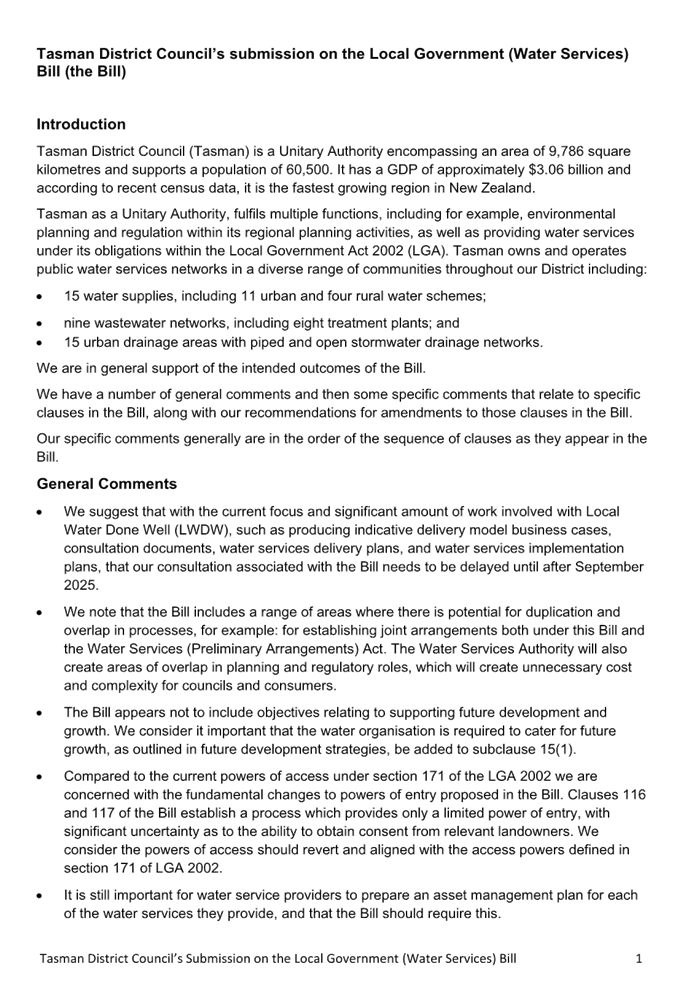

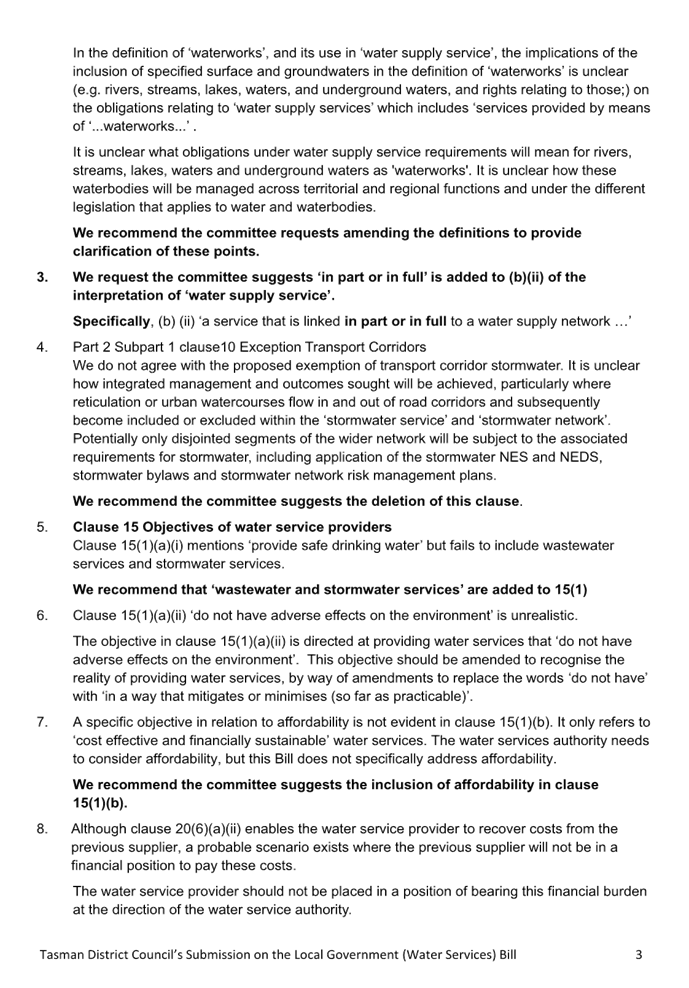

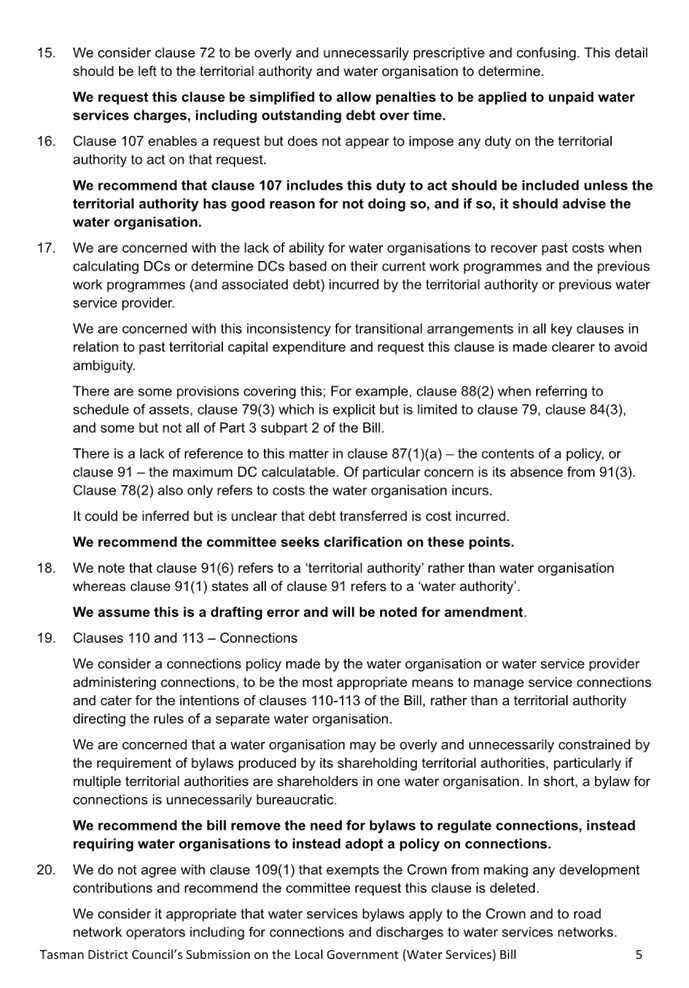
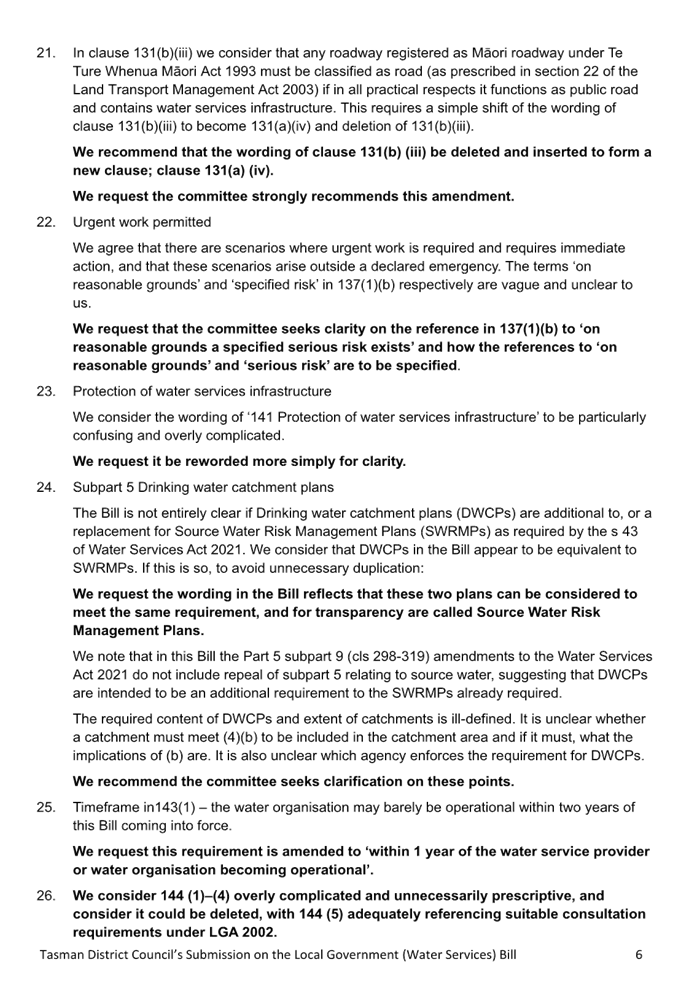
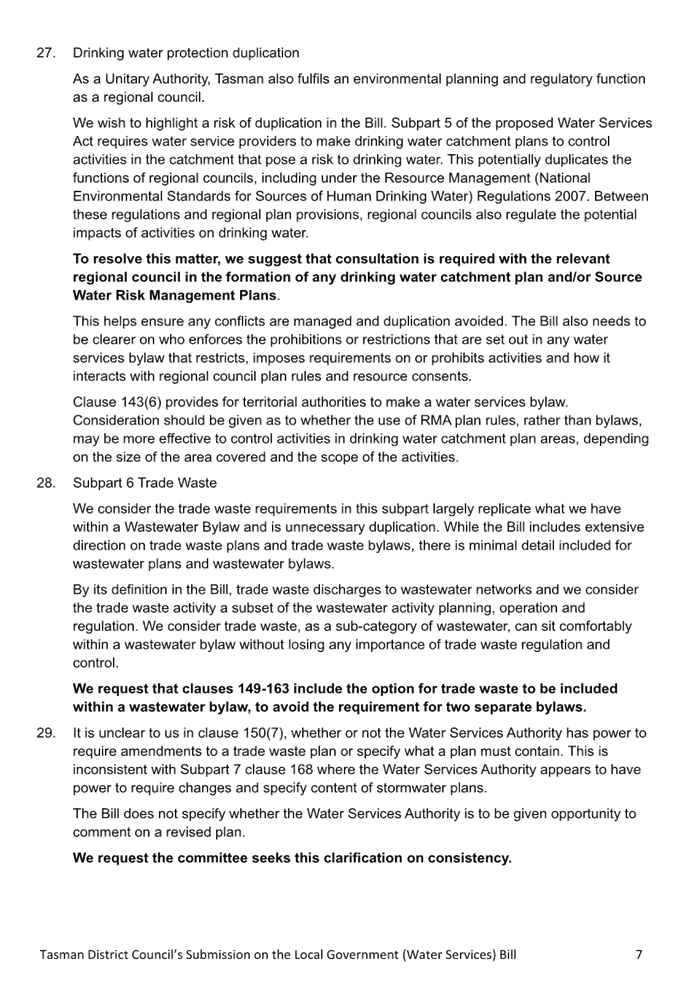
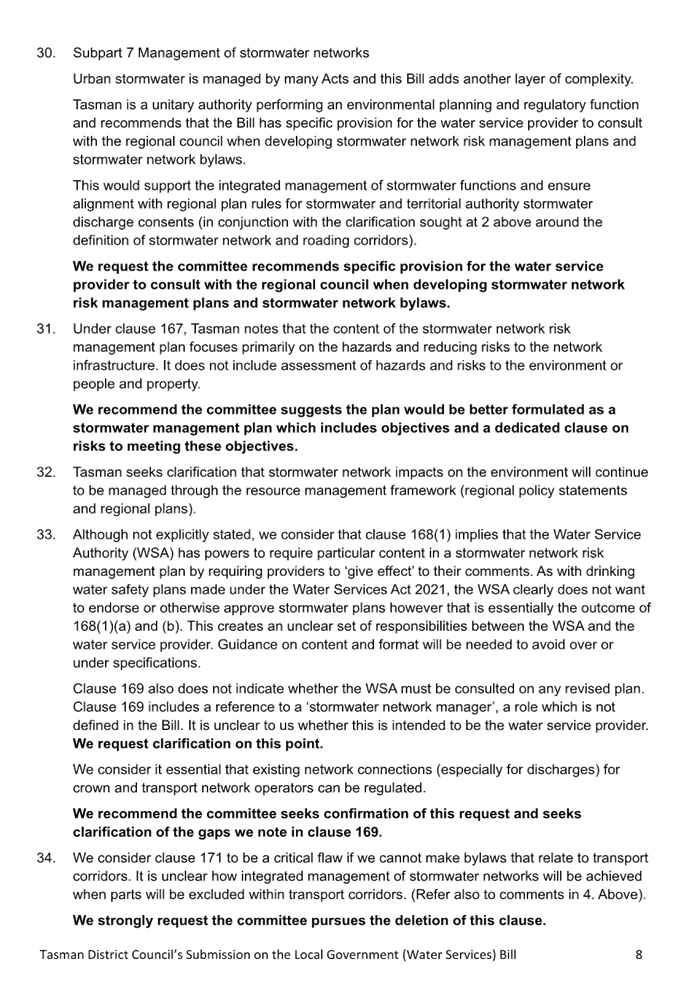
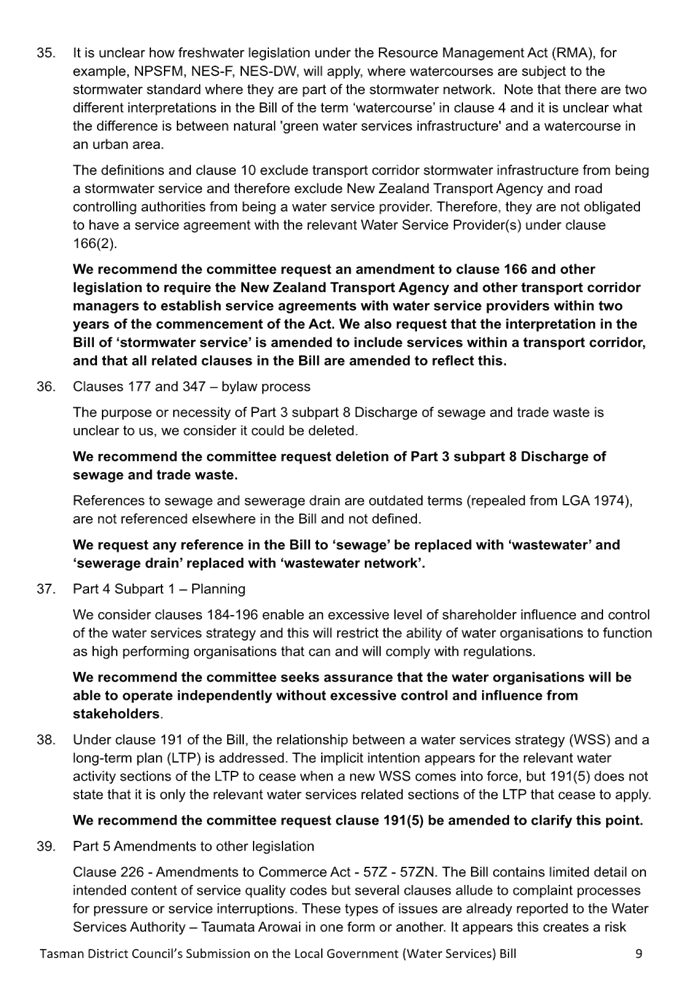
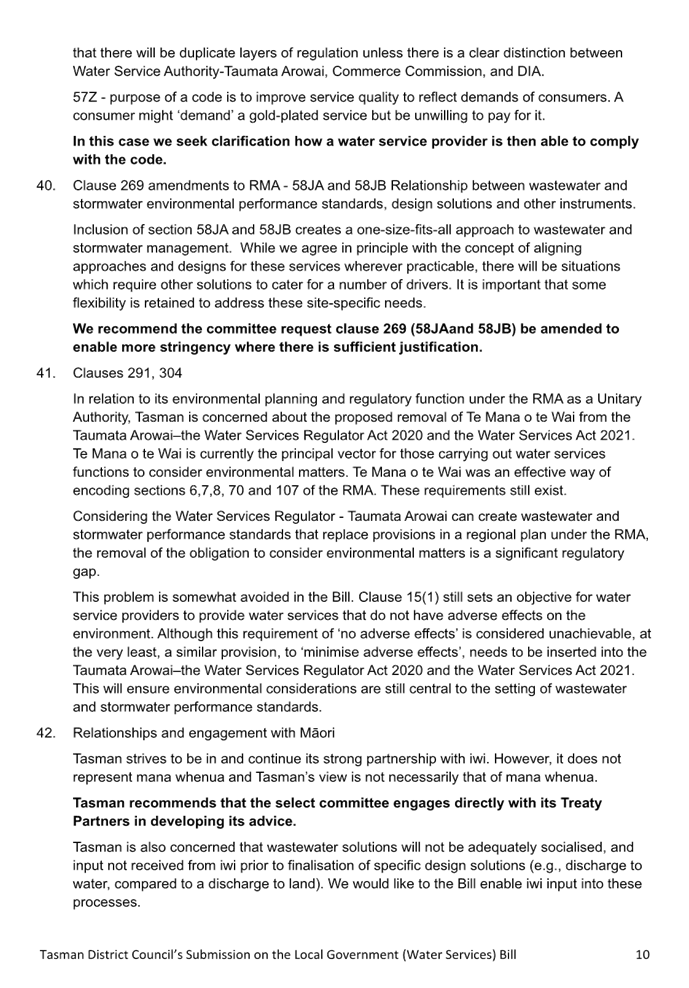
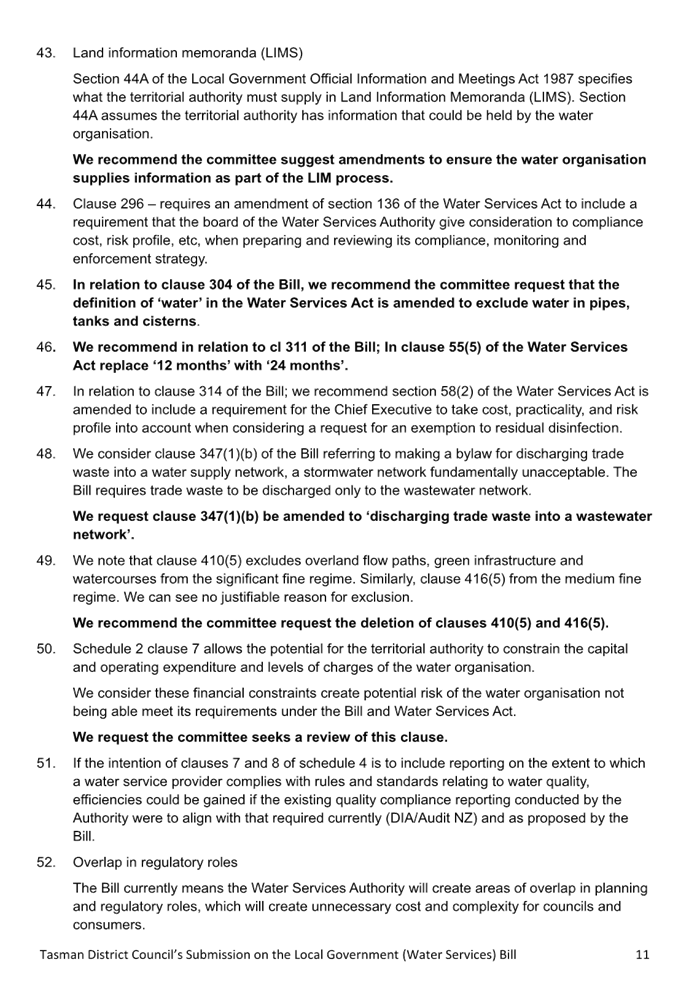
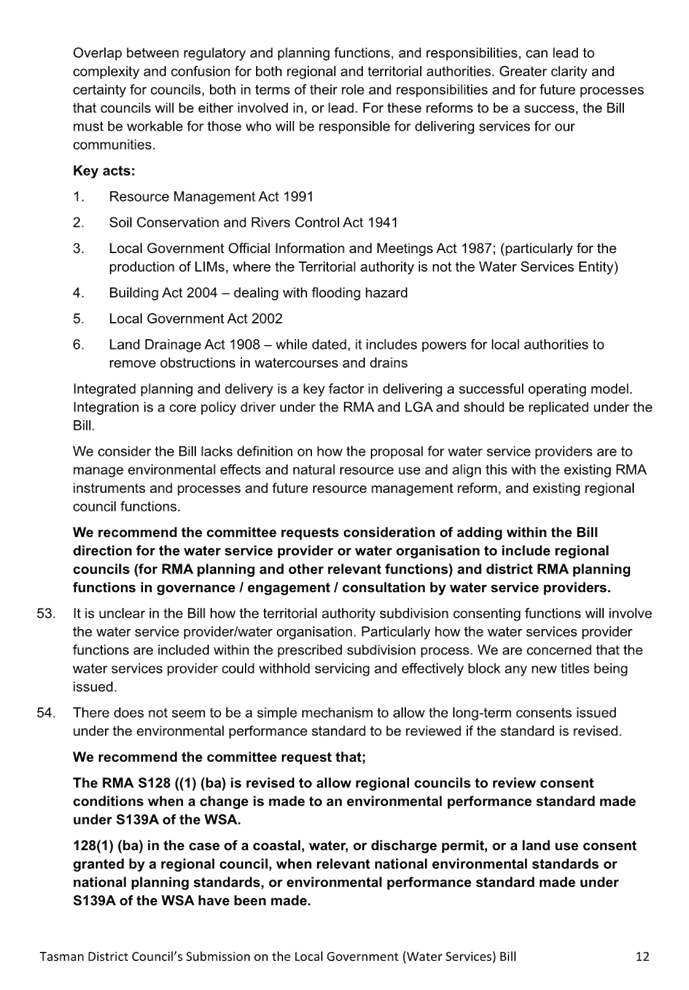
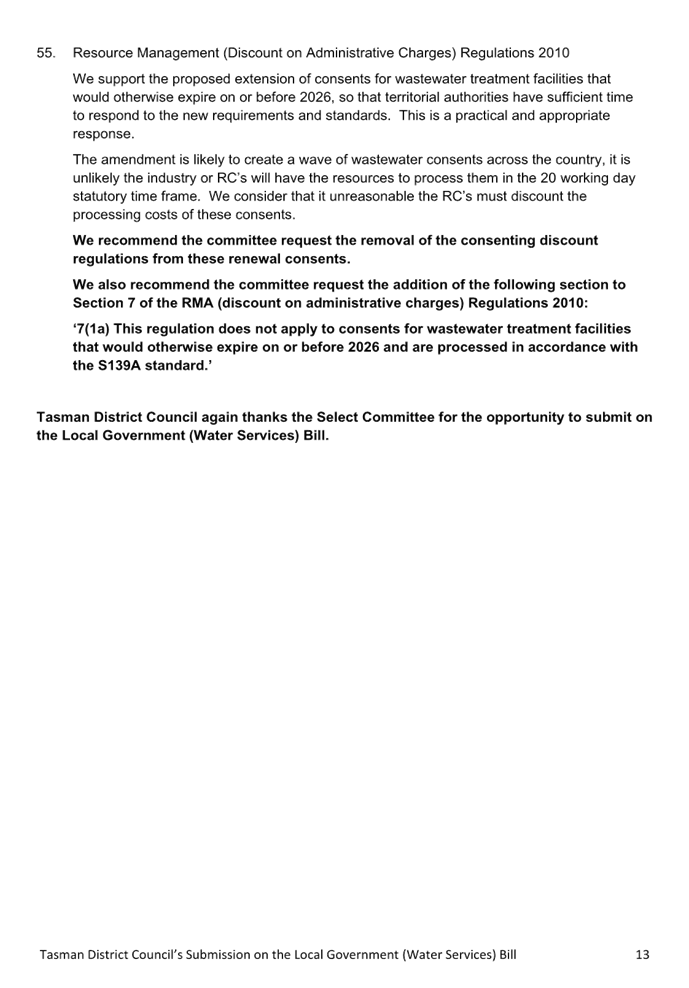
Environment and Regulatory Committee Agenda – 11 March 2025
7.3
Group Manager's
Report
Information Only - No Decision
Required
|
Report
To:
|
Environment
and Regulatory Committee
|
|
Meeting
Date:
|
11
March 2025
|
|
Report
Author:
|
Kim
Drummond, Group Manager - Environmental Assurance
|
|
Report
Authorisers:
|
Rob
Smith, Group Manager - Environmental Science
|
|
Report
Number:
|
RRC25-03-3
|
1. Summary
/ Te Tuhinga Whakarāpoto
1.1 To
update the Environment and Regulatory Committee on environmental and regulatory
activity since the last Committee meeting on 21 November 2024.
1.2 The
intervening period between Committee meetings can be characterised as a mix of
delivering on current environmental and regulatory responsibilities, while
engaging in Government-driven reform processes in situations where Tasman had
an active interest and was well placed to make a meaningful contribution. In
other situations, we were able to defer to the sector wide perspectives offered
by Taituarā and/or Te Uru Kahika.
1.3 The
period also covered the summer holiday break where staff were encouraged to
take time out to spend with family and friends off the back of a busy year, and
in anticipation of more change in 2025. I acknowledge that some staff remained
on call or were actively working through the holiday break to monitor
compliance with regulatory requirements.
2. Recommendation/s
/ Ngā Tūtohunga
That the
Environment and Regulatory Committee
1. receives
the Group Manager's Report RRC25-03-3.
3. Progress with the Government’s Reform agenda
3.1 At
the last meeting of the Environment and Regulatory Committee meeting held on 21
November 2024, progress with the Government’s legislative reform agenda
was discussed. An update of key reforms that the Council and/or staff have
engaged in is set out below.
Fast-track Approvals Act
3.2 The
Act came into force on 23 December 2024. The new Act combines multiple approval
processes from previously different legislation which were typically invoked
for large and/or complex projects. As such it provides for an alternative to
the current processes for obtaining resource consents, permissions and
approvals under the Resource Management Act 1991 (RMA) or other Acts.
3.3 A
nationwide spread of 149 infrastructure and development projects are included
in Schedule 2 of that Act which came into force on 7 February 2025. The
projects listed in Schedule 2 of the Act can apply to have expert panels make
decisions and set conditions on these projects. Two of these projects are in
the Tasman District. New applicants can apply to the Minister for
Infrastructure for referral.
3.4 A
Fast-track website, administered by the Environment Protection Agency opened on
7 February. The website includes information on the Fast-track regime, an
applications portal, and system tools for applicants and government agencies,
as well as Councils that are involved in individual application processes.
Resource Management Act (Consenting and Other System
Changes) Amendment Bill
3.5 The
Resource Management Act (Consenting and Other System Changes) Amendment Bill
was introduced to the House on 9 December 2024. A key intent of the Bill is to
progress Government priorities, including making it easier to consent new
infrastructure, encouraging investment in renewable energy, and making
medium-density residential standards optional for councils.
3.6 The
timeframe for submissions to the Bill was remarkably tight and it was therefore
a key focus for staff returning to work early in the year. Retrospective
approval of the submission signed by the Mayor is an agenda item at this
meeting. The Mayor and key staff orally presented to the Environment Select
Committee on 20 February 2025.
Proposed Regulatory Standards Bill
3.7 The
Ministry of Regulation released a discussion document on a proposal to
introduce a Regulatory Standards Bill at the end of 2024. Submissions we due in
late January. The ideas that underpin the proposal for a Regulatory Standards
Bill are similar to former Bills that parliament has examined on three previous
occasions – twice in depth. The drive behind the latest proposed Bill
comes from the coalition agreement between the National and Act parties.
3.8 Both
Taituarā and Te Uru Kahika submitted on the proposed Bill. On that basis,
our staff did not prioritise resources towards preparing a submission for
consideration by elected members. The coalition agreements suggest a Bill will
be introduced into parliament at some point during the current term.
Local Government (Water Services) Bill
3.9 The
Bill was introduced on 10 December 2024 and referred to the Finance and
Expenditure Select Committee. Submissions closed on 23 February 2025. Retrospective
approval of the submission signed by the Mayor is an agenda item at this
meeting.
3.10 In
addition to the proposed legislation, and in line with recent legislative
changes, Taumata Arowai (Water Services Authority) is proposing national
environmental performance standards through the release of a discussion
document. These standards have largely been proposed in recognition that around
60% of council-owned wastewater treatment plants are due to be re-consented
within the next decade, with around 20% of these plants currently operating on
expired consents (although none of these are in Tasman).
3.11 Having
the proposed standards in place is estimated to save territorial authorities up
to 40% in consenting costs. The inherent challenge for the regional sector of
local government is to ensure that there is synergy with the roles assigned to
Taumata Arowai with the role of the regional sector under the RMA.
3.12 Submissions
are due with Taumata Arowai by 24 April 2025. Staff are currently evaluating
the merit of the Council providing a submission or whether it would be
sufficient to defer to Taituarā and Te Uru Kahika.
Proposed reform of the Building Act 2004
3.13 As
advised in the GM Report to the 21 November 2024 meeting of the Committee, the
Government is investigating significant reform of the building consent system.
Aotearoa New Zealand has 67 Building Consent Authorities implementing and
enforcing a single national building code. The Government considers this
structure leads to confusion and frustration in the construction sector, as
well as inefficiencies and delays.
3.14 The
report from the Building Assurance Manager provides an update on where the
reform initiative is at, together with an update on proposed changes to the
Building Code.
Proposed reform of Local Government
3.15 In
December 2024 the Government announced that it had agreed to reforms that will
refocus local councils on delivering essential services and core
infrastructure, spending responsibly, and operating under greater scrutiny. The
proposed reform programme will:
3.15.1 Remove
references to the ‘four well beings’ from the Local Government Act
2002, restoring a purpose focused on fixing pipes, filling potholes, and
delivering core local services.
3.15.2 Refocus
local government on basics, guiding council decision-making and avoid
duplication of roles with central Government.
3.15.3 Benchmark
council performance: The Department of Internal Affairs will publish a yearly
report on key financial and delivery outcomes, helping ratepayers hold councils
accountable.
3.15.4 Modernise
outdated rules, including removing requirements for newspaper notices, to drive
efficiency and cost savings.
3.16 Cabinet
will consider additional measures which will be included in legislation
introduced mid-2025 and passed by the end of 2025. These will consider
investigating rates pegging similar to New South Wales, reform of auditing
review requirements, and establishment of a written question system to give
councillors more access to information.
Upcoming National Direction
3.17 As
noted in my previous Group Manager report, the Government has signalled a
package of National Direction changes that will be delivered through the RMA.
These changes are nominally a component of Phase two of the RMA reforms but are
expected to be enduring in that they will be carried over into the replacement
of the RMA (phase three).
3.18 The
initial intention was to be consulting on this package prior to the end of the
year. However, at the time of writing the proposals had yet to be launched.
Indications are that the package of proposals will not be ready until the
second half of the year.
Proposals to modernise the Conservation System
3.19 On
15 November 2024, the Government released two discussion documents that
included proposals to:
3.19.1 Explore
charging for access to some public conservation land
3.19.2 Streamline
concessions and planning processes and enable more flexibility around land
exchange and disposals.
3.20 The
discussion documents are seeking public feedback to inform policy reform. An
opportunity for staff to engage was provided by the Department of Conservation
(DOC) via two webinars in late January 2025.
3.21 Staff
are unclear about the potential for the reforms to impact on the Abel Tasman Foreshore
and Scenic Reserve, the Management Plan and the Management Committee. For that
reason, a submission has been provided to DOC seeking further clarity on
possible impacts. Senior staff within DOC have also been approached with a view
to having more information made available. Nevertheless, it became clear that
making a submission was the only way to ensure our concerns would be noted.
Accordingly, a short submission was lodged by the Group Manager Environmental
Assurance on 28 February, the deadline for submissions.
Adapting to Climate Change
3.22 The
Finance and Expenditure Committee completed their inquiry into climate
adaptation and published a report containing proposed objectives, principles
and other adaptation system recommendations. The Government response to the
inquiry was published in January 2025, and at the time of writing a
Parliamentary debate on the inquiry was scheduled for 15 March 2025.
3.23 The
Government is now focussing on developing policy including potential
legislative elements to bolster the framework. The objectives agreed to by
Cabinet in 2024, subject to change pending policy decisions in 2025 were:
3.23.1 Minimise
expected long-term costs to New Zealand
3.23.2 Provide
certainty for property owners about what support will be available to help with
recovery and clarity about the roles of central government, insurers, local
government and other groups
3.23.3 Improve
climate risk and response information flows to help everyone make informed
decisions
3.23.4 Ensure
people have the incentive and the ability to manage risk and reduce impacts
where they can
3.23.5 Maintain
efficient housing, financial and insurance markets.
3.24 One
part of the new national direction being developed is to provide direction to
councils on natural hazards such as floods and landslides when planning for new
land use activities. As previously advised to the Committee, the Government has
decided to progress national direction for natural hazards through a single
national instrument, to be in place by mid-2025. This is expected to provide
direction to councils on how to identify natural hazards, assess the risks, and
respond through their consenting and planning.
3.25 Our
Council is gearing up for this emphasis by making natural hazard maps more
readily available (see below). We are also taking steps to ensure upcoming
requirements for hazard information to be included in LIMs can be delivered on.
4.1 The
first stage of Council’s new Environmental Map Viewer has gone live with
the release of natural hazards maps. While a range of maps on natural hazards
such as liquefaction and sea-level rise have been available on the Council
website for some time, the new map viewer brings this data together into one
location making it easier than ever for the public to access. The new map
viewer also for the first time makes flood model information publicly available
through the use of a ‘flood model filter’ which enables users to
easily filter flood model data to view different flood scenarios including the
effects of climate change.
4.2 The
natural hazards pages on the Environmental Map Veiwer is the result of a
significant effort by a range of teams across Council including the GIS team,
the Environmental Policy team, and the Natural Hazards team, as well as support
from a range of project managers. In the future the Environmental Map Viewer
platform will be extended to make available other environmental map data held
by Council, adding to its utility as a ‘one stop shop’ for the
public wishing to access Council’s environmental spatial information.

Figure 1: Screen shot of the new Hazards Map view option on the
Council website
5.1 The
Red Eared Slider turtle, spotted in 2019 and reported on to this Committee in
the Group Manager’s report from 14 March 2024, has finally been trapped. This is good news for
the biodiversity of Lake Killarney, and it attracted media coverage. There is
ongoing work across the region to catch other turtles as we are notified of
their presence.
6. Regional On Scene Commander
Background
6.1 Tasman
District Council has a responsibility under the Maritime Land Transport Act
1994 to conduct a Tier 2 or regional response to any marine oil spills that
occur within the coastal marine area.
6.2 As
part of this we, along with Nelson City Council (NCC), operate a joint oil
spill response capability and have a joint Regional Marine Oil Spill
Contingency Plan, and Regional On-Scene Commander(s) (ROSC) appointed for each
region.
6.3 To
facilitate the work required to meet this responsibility, Nelson City and
Tasman District Councils have redirected resource to create a 0.5FTE regional
coordination role. This role is hosted by the Nelson Tasman Emergency
Management team and operates within the committee structure and reporting lines
shown below. We anticipate that future updates will be provided as part of the
Harbourmaster’s report.
Status
Update
6.4 The
Regional Marine Oil Pollution Readiness and Response Coordinator role has been
established. Kay Anderson has been appointed to this role.
6.5 There
is a Marine Oil Spill MOU in place between Nelson City Council and Tasman
District Council.
6.6 Existing
challenges and immediate priorities have been identified:
6.6.1 Running
a responder training exercise in March 2025
6.6.2 Establishing
the operational reporting structure and budget lines for the role
6.6.3 Updating
the Regional Oil Spill Contingency Plan to make it current and fit for purpose
6.6.4 Determining
and implementing a work programme for the auditing process of Tier 1 oil
transfer sites
6.6.5 Developing
a Regional Marine Oil Pollution Readiness and Response Coordinator work
programme
6.6.6  Training,
and then appointing, an alternate ROSC for our Council.
Training,
and then appointing, an alternate ROSC for our Council.
7. Harbourmaster’s
Office
Navigation Aids
7.1 Navigation
aids have presented ongoing challenges due to a fault in the top of the
anchoring system, causing several floats to come adrift. All but one of the
floats have been recovered, and the remaining floats have been inspected for
the same fault. The missing float is suspected to have been stolen from Port
Tarakohe, despite rumours that they contain lead ballast; they actually contain
gravel and foam.
7.2 Several
new navigation aids have been installed under a Section 200 delegation from
Maritime New Zealand (MNZ), with some requiring full MNZ approval. These aids
will be permanently added to the Abel Tasman chart improving Navigation safety
and Council’s compliance with national requirements.
Controlled Anchoring
7.3 Controlled
anchoring has been initiated with five anchoring sites established. These sites
will appear on the coastal chart over the next few months. Vessels over 40
meters or 500 tons are directed to these anchorages, with fees applied to cover
the costs managing safety and surveys. A few cruise ships have utilised these
anchorages, and we anticipate greater uptake from the yacht industry over time.
Additionally, there are three anchorages off Port Nelson, for which fees are
not currently charged and so these sites tend to get higher usage. Tasman HMO
is working collaboratively with the Nelson Team with a view to achieving
greater alignment of fees and charges.
Safer Boating Initiatives
7.4 Over
330 safer boating surveys have been completed in Tasman over the summer, with
data captured and collated by MNZ. The information will help tailor future boat
safety initiatives. Early figures indicate that 11% of boaters on vessels under
6 meters are not wearing life jackets. Safer Boating also funded several
projects in Tasman, including free SUP courses and Iwi ramp educators in Golden
Bay, which have received positive feedback. Data from these initiatives is
still being collated. The summer student program enabled the HMO to have two
crews on the water at times, conducting boat ramp surveys and checks while
keeping overtime down. Funding was also received for remote patrols in Tasman,
with one three-day patrol completed and more planned, weather permitting. The
vessel Pūkāea conducted patrols from Westhaven Bar to Kahurangi
Point, the Kahurangi shoals, Farewell Spit, Collingwood, and Tata Beach.
Wrecks and Rescues
7.5 There
have been very few incidents this summer, with only two tow jobs and one FENZ
call-out. The HMO has been on standby for a small number of rescues, but they
were resolved without our involvement. The plane that crashed has been located
and due to the risks, the wreckage poses it is to be salvaged in the near
future. Costs of that will sit with the insurer.
Navigation Safety Notice
7.6 A
Navigation Safety Notice has been issued for the marine farms offshore from the
Motueka River Mouth. Unmarked floating ropes have been discovered in this area,
with the Harbourmaster Office working to identify the hazards and mitigate any
risk to vessels.
7.7 Boaties
were reminded via a media release that:
7.7.1 Maritime
Rules prevent vessels from exceeding 5 knots within 200m of a marine farm.
7.7.2 Boaties
are discouraged from navigating through these farmed areas, as hazards include
floating, sub-surface, and sunken lines and structures.
7.7.3 It
is recommended that courses are plotted around the outside of the marked area,
particularly if it is dark or there is poor visibility or rough weather.
7.7.4 Anchoring
is not advised due to multiple hazards on the sea floor which are unmarked.
7.8 The
Notice is in effect from 26 February 2025 until further notice.
Issues under investigation
8.1 The compliance monitoring team
was on call over the holiday period with no significant issues requiring
enforcement action. In more recent weeks there have been a few issues that have
attracted public interest and are currently under investigation.
8.2 These
include an uncontrolled sewage discharge event from the Nelson Regional
Business network on the morning of 25 February 2025. A second issue involves
unmarked floating ropes within the Aquaculture Management Area within Tasman
Bay that has resulted in a Navigation Safety Notice being issued by the
Harbourmaster on 26 February 2025.
Before the Court
8.3 An
appeal and an application for stay was lodged by the respondents, against the
decision of the Environment Court regarding a tiny home in the Upper Moutere.
The appeal hearing was held in the Nelson High Court on 17 February 2025.
8.4 The
decision has been reserved and while an explicit timeframe for a decision was
not given, it is considered unlikely to be within the next three months.
Ministry
for Primary Industries Food Business Levy Fee
8.5 The
Ministry for Primary Industries (MPI) will introduce an annual food business
levy on 1 July 2025, to fund the food safety system.
8.6 It
applies to domestic food businesses registered under the Food Act 2014, with
charges phased in over three years: $57.50 per site in 2025, $86.25 in 2026-27,
and $115 from 2027-28 onward. This amount is charged for each registered
location a business operates, so a company with multiple sites will pay the
levy for each one.
8.7 For
businesses registered with a local council (territorial authority), the council
will collect the levy on MPI’s behalf and may add a small administrative
fee (up to $11 per site) to cover collection costs. Businesses registered
directly with MPI will have the levy collected by MPI itself.
8.8 The
levy—expected to raise $5.7 million yearly—will support food safety
rules, compliance monitoring, and business guidance.
Nil
7.4 Building Assurance Manager's Report
Information Only - No Decision
Required
|
Report
To:
|
Environment
and Regulatory Committee
|
|
Meeting
Date:
|
11 March
2025
|
|
Report
Author:
|
Matt
Feely, Building Assurance Manager
|
|
Report
Authorisers:
|
Kim
Drummond, Group Manager - Environmental Assurance
|
|
Report
Number:
|
RRC25-03-4
|
1. Summary
/ Te Tuhinga Whakarāpoto
1.1 Tasman
District Council is legally required under the Building Act 2004 to perform the
functions of a Building Consent Authority (BCA) and must maintain accreditation
under the Building Regulations 2006. This is reinforced as a performance
measure under a related level of service in our 10-year plan. Assessments are
carried out by International Accreditation New Zealand (IANZ),
and our next one is due in October 2025.
1.2 In
addition to the IANZ audit, Territorial Authority (TA) assessments are carried
out by the Ministry of Business, Innovation and Employment (MBIE) to ensure
Councils have the appropriate systems, processes and resources to carry out
their core functions under the Building Act 2004. In the latest review, two
areas of potential concern were identified and we have provided evidence in
response. We are still awaiting a response from MBIE but we consider the areas
of concern are currently being appropriately managed. The next TA assessment
has not been confirmed but is likely to be in the first half of 2026.
1.3 MBIE’s Building
Performance Team are progressing work to identify the best way to advance the
Government’s Building Consent Authority (BCA) reform agenda. A discussion
document supported by public consultations is likely to be announced over
coming months.
1.4 In
terms of current work, Building Consent applications are similar to 2023
– 2024 volumes. This is in line with expectations and budgets have been
set on that basis. Those budgets were set following adjustments to fees and
charges for this financial year and changes to the Building Assurance section
to reflect the lower demand.
1.5 As
well as meeting budgetary requirements we have maintained 99% compliance with
our statutory time frames and Building Warrant of Fitness (BWoF) audits and
pool barrier inspections are both meeting legislative requirements.
1.6 With
the recent drop in the Official Cash Rate, we are expecting this will push
volumes of Building Consent applications up slightly, but we are not likely to
see the impact of that until the 2025 – 2026 year. At that point we are
likely going to call on increased work from our external contractors to meet
demand.
1.7 The
government is presently undertaking a review of the management of seismic risk
in existing buildings. The purpose of the Review is to ensure seismic risk in
existing buildings is being managed effectively and in a workable,
proportionate way. The Building Assurance Section will likely have some
involvement in this.
2. Recommendation/s
/ Ngā Tūtohunga
That the Environment
and Regulatory Committee
1. Receives
the Building Assurance Manager's Report RRC25-03-4
3.1 We have had one
resignation this year from a Building Technical Officer – Processing.
This position will not be replaced; we have sufficient Contractor resource to
provide cover.
3.2 The
recruitment for the Team Leader – Building Compliance Officer role was
successful, Angelique Akaruru commenced on 11 November 2024.
4. Building Consent Authority functions and delivery
4.1 One Building Technical Officer
– Inspector is in his second and final year of the Level 6 Diploma in
Building Surveying.
4.2 Service
delivery has been maintained at 99% within statutory timeframes for building
consents and code compliance certificates.
4.3 Customer
engagements have continued with Certified Builders and Master Builders
quarterly meetings. Council has continued its quarterly Building Assurance
newsletter, which informs our key customers of important updates, legislation
changes, and any other relevant matters.
5. Compliance team function and service delivery
5.1 The
compliance section of Building Assurance has continued to undertake all the
relent Territorial Authority responsibilities under the Building Act that are
not otherwise performed by the building consents team. This includes:
5.1.1 Inspections
of Pool Fencing
5.1.2 Processing
Building Warrants of Fitness (BWoF)
5.1.3 Audits
of BWoFs
5.1.4 Processing
building consent exemptions
5.1.5 Processing
Certificates of Acceptance (COAs)
5.1.6 Investigating
and resolving complaints
5.1.7 Compliance
Investigation/ Enforcement
5.1.8 Issuing
Notices (Notices to Fix, Dangerous and Insanitary, Infringement Notices,
Certificates for Public Use etc)
5.2 TA assessments are carried out
by the Ministry of Business, Innovation and Employment (MBIE) to ensure Council
have the appropriate systems, processes and resources to carry out their core
functions under the Building Act 2004. MBIE conducted a TA assessment in
February 2024 and the final assessment report was released on 20 June 2024. The
review focused on dangerous, affected, or insanitary buildings and Certificates
for public use.
5.3 Two
areas of significant concern were identified: compliance of an issued
‘Dangerous, Affected, and Insanitary’ (DAI) building notice, and
Certificate for Public Use (CPU) issuing time. Evidence has been submitted in
relation to these concerns, and we await a response from MBIE. Notwithstanding
the delay, our understanding is that the areas of concerns are currently being
appropriately managed. The next TA assessment date is yet to be confirmed but
is likely to be during the first half of 2026.
5.4 Tasman
has 1799 pools that must be inspected every three years. We are continuing with
these inspections and still finding non-compliance, but the majority of these
can be resolved quickly and without issue. Some do come with challenges that
can take significant time to resolve. We currently have 45 non-compliant pool
barriers.
5.5 We
forecast issuing 96 Discretionary Exemptions for the 2024-2025 financial year.
To date we have issued 60 Discretionary Exemptions, which is 62% of the
expected forecast. Based on this and assuming the trend continues we expect to
be above (5-10%) the forecasted volume. The most common exemptions continue to
be for sheds, garages, insulation, marquees and earthquake strengthening work.
5.6 We
forecast issuing 50 Certificates of Acceptance (COAs) for the 2024-2025
financial year. To date we have issued 48 COAs, which is 96% of the expected
forecast. Based on this and assuming the trend continues we expect to be
significantly above (50-60%) the forecasted volume, however the previous year's
performance does suggest a reduction in volumes in the second part of the year.
5.7 We
have continued to audit 20% of Building Warrants of Fitness and so are meeting
MBIE guidelines. Complaints and investigations are ongoing in relation to
unauthorised building works.
5.8 Building
Compliance results from 1 July 2023 to 30 June 2024 are shown highlighted in
the table below with comparisons to the past five years.
|
Building Compliance
|
1 July 2019 to 30 June 2020
|
1 July 2020 to 30 June 2021
|
1 July 2021 to 30 June 2022
|
1 July 2022 to 30 June 2023
|
1 July 2023 to 30 June 2024
|
1 July 2024 to 31 January 2025
|
|
Compliance
Schedule Issued
|
39
|
42
|
21
|
23
|
27
|
23
|
|
Compliance
Schedule Amendment Issued
|
Statistic not available.
|
Statistic
not available.
|
264
|
117
|
149
|
96
|
|
Building
Warrant of Fitness
|
260
|
220
|
471
|
534
|
499
|
280
|
|
Building
Warrant of Fitness Audits
|
Statistic not available.
|
Statistic not available.
|
Statistic not available.
|
47
|
160
|
131
|
|
Schedule
1(2) Exemptions Issued
|
185
|
141
|
127
|
77
|
101
|
60
|
|
Certificate
of Acceptance Issued
|
38
|
35
|
30
|
50
|
43
|
48
|
|
Notices
to fix issued
|
29
|
14
|
24
|
54
|
45
|
13
|
|
Status
|
As of May 2022
|
As of April 2023
|
As of October 2023
|
As of February 2024
|
As of February 2025
|
|
Total
Pool licenses
|
1551
|
1750
|
1781
|
1799
|
1799
|
|
Total
Pools non-compliant
|
156
|
84
|
20
|
43
|
43
|
|
Pools
removed/decommissioned
|
191
|
225
|
249
|
269
|
269
|
|
Average
monthly Pool inspections
|
40
|
48
|
78
|
32
|
32
|
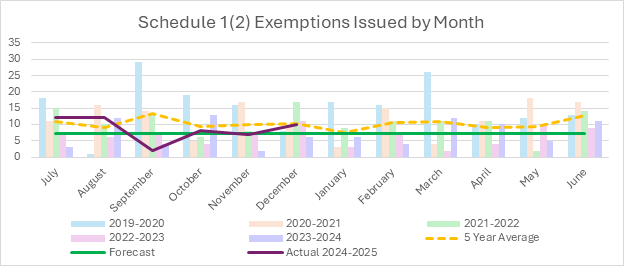

6.1 Determinations
are made by MBIE on matters of doubt or dispute concerning building work.
Rulings are legally binding on a case-by-case basis. Previous determinations
may provide useful guidance for subsequent issues as they arise, although
individual circumstances may vary. Our Building Assurance does not have any
determinations with MBIE
6.2 Complaints
can be made to the Council by practitioners. There are currently no such
complaints.
7. Dam
Safety Regulations
7.1 The
number of Potential Impact Classification (PICs) received to date are not
representative of the number of known classifiable dams in our district; this
pattern of under-representation is common across the country.
7.2 We
consider any follow up action must be consistent with other councils. Methods
to bring about supply of classifications are currently being developed but we
are not aware of any Dangerous Dams within the district.
7.3 A
measured approach is to be taken as there are significant initial and ongoing
costs imposed on owners of classifiable dams. So much so, that some owners are
giving serious consideration to decommissioning and removal.
8. Earthquake
Prone Buildings
8.1 We
continue to meet our Earthquake Prone Building obligations under the Act and
are moving toward the identification of non-priority buildings by 1 July 2027.
8.2 The
government is presently undertaking a review of the management of seismic risk
in existing buildings. The purpose of the Review is to ensure seismic risk in
existing buildings is being managed effectively and in a workable,
proportionate way.
8.3 At
a high level, the Review will include:
8.3.1 considering
society’s expectations and willingness to pay to mitigate the risk of
injury and death in an earthquake, and for improving the resilience of
buildings over time
8.3.2 recommending
regulatory responses that balance life safety risks against the costs of
regulation and impact on private property owners
8.3.3 identifying
barriers to meeting regulatory requirements and the types of support or
incentives that would help building owners to better manage seismic risk
8.3.4 considering
how outcomes from seismic risk requirements align with broader Government
objectives.
8.4 Building
Assurance will be engaging with this review.
8.5 Notices
for buildings that have an earthquake-prone building (EPB) notice with a
deadline on or after 2 April 2024 are being reissued with a 4-year extension to
their notice expiry. There is an option for the Government to extend this up to
a further 2 years thereby allowing owners of earthquake-prone buildings
additional time to remediate their buildings whilst the review takes place.
8.6 Additionally,
notices are now being issued for those buildings that have not had engineering
assessment supplied to the authority by the building owner.
9. Government
initiatives update
9.1 As
noted in the GM Report to the 21 November 2024 meeting of the Committee, the
Government is investigating significant reform of the building consent
system. MBIE’s Building Performance teams are progressing work to
identify the best way to deliver consenting services. This work includes
looking at:
· The
way BCAs are structured
· The
scope of building work exempt from a building consent, and
· Liability
settings and the role of private insurance in the consent system.
9.2 Initial
ideas for improving BCA services are:
· Making
it easier for BCAs to consolidate their services
· Establishing
regional consenting authorities, or
· Establishing
a national single point of contact for building consent applications
9.3 MBIE
is also looking at what building work could be exempt from building consents
and potential changes to liability settings across the whole building system.
This may include ways of providing for private insurance to take a greater
role, potentially as an alternative to a building consent.
9.4 This
work is being done in addition to work already underway to improve the existing
building consent process, such as:
· Making
it easier to build granny flats
· Increasing
the uptake of remote inspections, and
· Mandating
the acceptance and use of overseas building products.
9.5 Over
the last few months, MBIE has been meeting with representatives across the
sector, gaining important feedback from those on the ground to help understand
the benefits and barriers of different options.
9.6 MBIE
have spoken with around 90% of New Zealand’s BCAs plus various industry
groups. Insights from these conversations were provided to the Government at
the end of last year. MBIE are currently working with the Building and
Construction Minister to identify a way forward.
9.7 At
a more applied level, MBIE is seeking feedback on changing the Building Code H1
Energy Efficiency requirements for insulation in homes and other buildings to
help building designers and also reduce costs and maintain energy efficiency.
The consultation closed at 5.00pm on Friday 28 February 2025.
10.1 We
forecast 1220 building consent applications for the 2024-2025 financial year.
To date we have received 666 applications, which is 55% of the expected
forecast. Based on this and assuming the trend continues we expect to meet the
forecasted volume (+ or - 5%).
10.2 We
forecast 1183 building consent will be issued for the 2024-2025 financial year.
To date we have issued 647 building consents, which is 54% of the expected
forecast. Based on this and assuming the trend continues we expect to meet the
forecasted volume (+ or - 5%).
10.3 We
forecast 449 building consents for new dwellings would be issued for the
2024-2025 financial year. To date we have received 225 applications, which is
50% of the expected forecast. Based on this and assuming the trend continues we
expect to meet the forecasted volume (+ or - 5%).
10.4 New
Dwelling Consents issued currently sits at 168 with a total of new dwellings at
186 as some Building Consents have multiple dwellings on them.
10.5 We
forecast 7152 building inspections to be undertaken for the 2024-2025 financial
year. To date we have conducted 3332 inspections, this is 46% of the expected
forecast. Based on this and assuming the trend continues we expect to be below
(15-20%) the forecasted volume.
10.6 We
forecast to issue 1005 code compliance certificates (CCC) for the 2024-2025
financial year. To date we have issued 499 CCC’s, which is 49% of the
expected forecast. Based on this and assuming the trend continues we expect to
be below (7-12%) the forecasted volume.
10.7
We have maintained 99% compliance with our statutory time frames and our
average for processing days is at eight.
10.8 Building
inspections are maintaining the two working day notice for bookings.
10.9 Building
Consent results from 1 July 2024 to 31 January 2025:
|
Building Consent Results
|
1 July 2019 to 30 June 2020
|
1 July 2020 to 30 June 2021
|
1 July 2021 to 30 June 2022
|
1 July 2022 to 30 June 2023
|
1 July 2023 to 30 June 2024
|
1 July 2024 to 31 January 2025
|
|
Building
Consent Applications
|
1430
|
1651
|
1601
|
1386
|
1138
|
666
|
|
Building
Consents Issued
|
1306
|
1486
|
1500
|
1376
|
1127
|
647
|
|
New
Dwellings Consents Issued (excluding amendments)
|
447
|
575
|
510
|
484
|
264
|
168
|
|
Number
of New Dwellings
|
498
|
619
|
559
|
592
|
280
|
186
|
|
Building
Consents processed within statutory time frame (%)
|
97%
|
99%
|
98%
|
99%
|
99%
|
99%
|
|
Average
processing days
|
12
|
11
|
10
|
9
|
7
|
8
|
|
Inspections
undertaken
|
7615
|
8624
|
7539
|
8127
|
6306
|
3332
|
|
Failed
Inspections (%)
|
44%
|
61%
|
68%
|
72%
|
67%
|
66%
|
|
CCC
Applications
|
1036
|
1286
|
1054
|
1259
|
1005
|
470
|
|
CCC
Issued
|
1088
|
1266
|
1060
|
1165
|
1029
|
499
|
|
CCC
Average processing days
|
2
|
5
|
6
|
6
|
5
|
7
|
|
CCC
processed within statutory time frame (%)
|
100%
|
99%
|
99%
|
99%
|
99%
|
100%
|
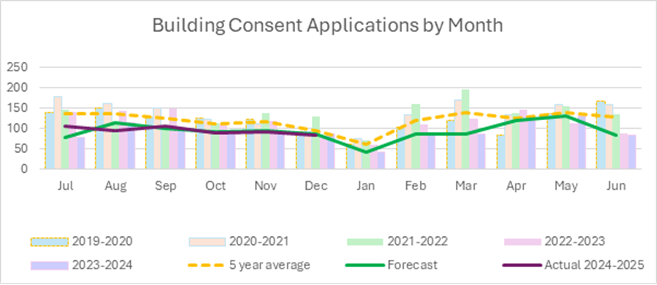
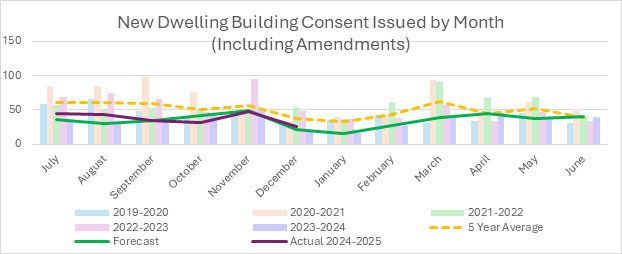
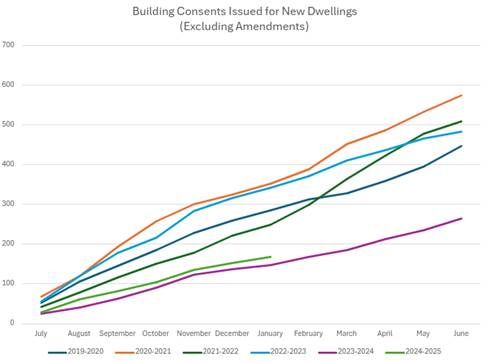
Nil
Environment and
Regulatory Committee Agenda – 11 March 2025
7.5 Resource Consents Manager's Report
Information Only - No Decision
Required
|
Report
To:
|
Environment
and Regulatory Committee
|
|
Meeting
Date:
|
11
March 2025
|
|
Report
Author:
|
Katrina
Lee, Resource Consents Manager
|
|
Report
Authorisers:
|
Kim Drummond,
Group Manager - Environmental Assurance
|
|
Report
Number:
|
RRC25-03-5
|
1. Summary
/ Te Tuhinga Whakarāpoto
1.1 This
report summarises the performance of the Resource Consents Section, within the
Environmental Assurance Group, for the six month period July to December 2024.
1.2 The
timeframe performance across all consent processing for the reporting period
was at 69% within 20 days, a slight improvement on 64% for the last period. In
cases where the 20 day timeframe has not been met, discount penalties provided
for in the legislation have applied.
1.3 At
the time of the last six-monthly report presented to the Environment and
Regulatory Committee meeting in August 2024, we had 63 unallocated consents. At
the time of writing this report we have 16 unallocated consents. We see
removing the back log as a key step to achieving the 20 day timeframe. So, we
have made progress on that front.
1.4 The
volume of consent applications received and decisions issued during this
reporting period were both higher than the last reporting period.
1.5 Overall,
across the breadth of the work we do in consenting – processing consents,
responding to service requests and Local Government Official Information and
Meetings Act requests (LGOIMAs) – the quantity of all these workstreams
has increased.
1.6 In
this six-month reporting period the discount penalties have increased on the
previous period, however overall they have remained lower than 2022. The key
drivers for the discount penalties that are still being incurred can be put
down to:
· It continues to be
difficult to attract and employ experienced and competent consent planners who
can work within statutorily implied timeframes
· Engaging
experienced contractors has also been a struggle, and when we do, they are
generally not locally based. This places additional challenges on team leaders
to manage quality of output in a timely fashion
· More and more
complex issues seem to be coming to us.
1.7 As
a result of still holding vacancies in the team we have been continuing to
contract out consents that we would prefer to process inhouse. Nevertheless,
over this reporting period we have seen a reasonable improvement in the
recovery of costs associated with using contractors. Our overall financial
performance, in terms of both revenue and costs, is within budget.
1.8 In January/February this
year, two staff resigned to pursue travelling and alternative career options.
One was a Senior Planner in the land use team, and the other a Consent Planner
in Subdivision. We are looking to recruit for both roles, as well as for a
Development Engineering Officer to cover time freed up by staff working reduced
hours. In January a new consent planner in land use started, who replaced
someone who left over 6 months ago.
1.9 The
team does not only process resource consents. A considerable amount of our time
is also spent responding to public enquiries (duty planning/service requests)
and LGOIMAs (information requests). Responding to service requests and
pre-applications can take consent planners away from consent processing, but it
is an investment that is likely to improve the quality of applications that do
come through to us.
1.10 We
also have multiple staff in the Resource Consents team that are involved in
commenting and contributing to building consents, Project Information
Memorandums (PIMs) and Land Information Memorandums (LIMs). These additional
statutory processes also have tight audited timeframes and staff need to meet
those demands – along with LGOIMA responses, responding to complaints and
service requests.
1.11 We
continue to service the Tākaka office through Council staff and
contractors and this is working reasonably well.
1.12 In
summary, while we are still facing challenging times, the output of the
consents team is growing. We are working within budget constraints but we will
not achieve the primary level of service.
2. Recommendation/s
/ Ngā Tūtohunga
That the
Environment and Regulatory Committee
1. receives
the Resource Consents Manager's Report RRC25-03-5.
3.1 This
report presents the performance results for the Resource Consents section for
the first half of the 2024/25 financial year, from July to December 2024. It
also provides some comparisons from previous periods. It provides a snapshot of
current workload, staff resourcing and shows where the section is sitting
alongside our performance targets.
4. Performance reporting July to December 2024
4.1 A
total of 555 applications for resource consents and other statutory
applications were received in the reporting period July to December 2024, the
six-month period before this was 511.
4.2 A
total of 378 decisions were made during this six-month period, compared to 352
in the last reporting period, totalling 730 for the financial year. This
reporting period and previous years are outlined in Table 1.
Table
1: Non-notified consents July to December 2024
|
Type of
Application
|
Number
complete
|
Number
complete
|
Number
complete
|
Number
complete
|
Number
complete
|
Number
complete
|
Percentage
Within Time (Incl s37)
|
|
Jan-
June 2022
|
July-Dec
2022
|
Jan-June
2023
|
Jul-Dec
2023
|
Jan-Jun
2024
|
July-Dec
2024
|
|
District
Land
|
246
|
213
|
207
|
233
|
187
|
204
|
73.27%
|
|
CN
Variations
|
10
|
13
|
6
|
15
|
12
|
7
|
57.14%
|
|
Subdivision
|
50
|
53
|
40
|
68
|
47
|
52
|
34.69%
|
|
Coastal
|
5
|
6
|
24
|
6
|
11
|
1
|
100.00%
|
|
Discharge
|
57
|
75
|
54
|
67
|
66
|
54
|
57.45%
|
|
Regional
Land
|
10
|
17
|
12
|
10
|
10
|
17
|
94.12%
|
|
Water
Permit
|
44
|
45
|
24
|
35
|
19
|
43
|
97.62%
|
|
Total:
|
422
|
422
|
367
|
434
|
352
|
378
|
69.21%
|
|
SHA
Consents
|
3
|
1
|
0
|
2
|
0
|
1
|
N/A
|
|
Boundary
Notices
|
34
|
27
|
14
|
23
|
13
|
8
|
37.50%
|
|
Others*
|
12
|
19
|
20
|
17
|
10
|
10
|
N/A
|
* Others include Right of Ways, Outline Plans and
Certificates of Compliance
4.3 The
timeframe compliance for the period has improved again since the last reporting
period. Last reporting period we compliance was 64% and this reporting period
it is 69%. This reporting period has seen the most applications received in a
6-month period for at least the last 2 years.
4.4 The timeframe compliance
for subdivision consents processed through to a decision has remained
consistent over the past 18 months. Land use consents (district) timeframes
have improved over the last 18 months, from 60% to 72%, to now 73%.
Table
2: Notified Applications July to December 2024
|
Type of
Application
|
Number
|
Number
|
Number complete
|
Number complete
|
Number
complete
|
Percentage
Within Time (Incl s37)
|
|
Complete
Jan-June 22
|
Complete
Jan-June 23
|
Jul - Dec 2023
|
Jan-Jun 2024
|
Jul-Dec
2024
|
|
Publicly
Notified (no hearing)
|
0
|
0
|
0
|
0
|
2
|
100%
|
|
Publicly
Notified (with hearing)
|
0
|
7
|
0
|
0
|
1
|
100%
|
|
Limited
Notified
|
13
|
10
|
7
|
5
|
2
|
100%
|
|
(no
hearing)
|
|
Limited
Notified
|
0
|
5
|
2
|
2
|
16
|
50%
|
|
(with
hearing)
|
|
Totals
|
13
|
22
|
9
|
7
|
21
|
61.90%
|
4.5 Table
2 shows the number of limited and publicly notified consents issued in the last
6 months. The last 12 months has been very busy in the hearings and notified
space. The 16 limited notified consents (with a hearing) related to three
developments as they were bundled consents across subdivision, land use,
discharge permits and a consent notice variation.
4.6 The
publicly notified consent with no hearing related to a Notice of Requirement
for a new designation for Council water reservoir off Hill Street South and
associated regional council consent. The other publicly notified consent, which
went to a hearing was for a billboard on corner of Gladstone Road and Queen
Street.
4.7 Section
6 of this report explains the current workload we have on for the next 6 months
around notified consents and hearings.
4.8 In
addition to final applications being lodged with Council we have also received
37 pre-applications this reporting period. These are enquiries that require
more review than a duty planning enquiry and need wider Council input. Consent
planners collate this feedback and respond with this, before a final
application is lodged.
4.9 During
this period, we have issued 41 section 224 certificates under the RMA. These
are certificates that mean subdivision conditions have been complied with, and
the consent holder can obtain new Record of Titles for their new lots. The 41
certificates totalled 192 new allotments being created in Tasman over the last
6 months.
Table
3: Discount Penalty Payments
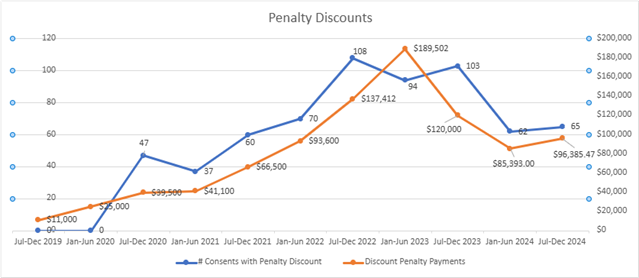
4.10 Table
3 shows in general a reduction in discount penalties (payments and the number
of consents) over the years paid out. However, it is noted that the discount
payments have slightly increased during this reporting period. One of the main
reasons for this increase was due to the increased pressure of notified
processes and hearing processes and overall the delayed time to allocate
consents to planners, due to staff resources.
4.11 Of
the 65 consents that received a discount penalty this reporting period, 23 of
these were bundled consents (i.e. across district and regional council
consents). 15 of the 65 were a 30% or above discount, but on average the
discount percentage was 18%.
4.12 Even
though this reporting period there has been a slight increase, overall the
discount penalties being paid out is low compared to previous years. We still
have some reasons for the discounts, as follows:
· Allocating and
finding experienced planners to process is still one of the most difficult
tasks and has been for a number of years.
· Fewer senior
planners has led to a shortage and ultimately delays in peer reviewing
letters/decisions that are sent out. This peer review work is required for
quality purposes to ensure a robust decision-making process.
· Complex
applications and issues, including consent conditions and affected parties.
· To ensure we make
informed decisions we rely on a number of internal staff to comment on resource
consent applications. However, due to staff outside the consenting team having
other workload deadlines etc these comments can be delayed. As a result, this
impacts the statutory timeframes.
· Multiple/bundled
consents being processed at once with many overlays (i.e. hazards, contaminated
soils, coastal, wetlands, highly productive land etc).
· Staff turnover and
handing over consents to new processing planners.
· Managing contract
planners and ensuring overall consistency across decision making.
· Managing and
interpreting National Policy Statements (NPS’s) and National
Environmental Standards (NES’s), and at times being seen as the
knowledge-holders for some of the consultant planners that are lodging resource
consent applications on behalf of applicants.
· Finally, the wider
Council demands on our team to contribute to outside the core processing time
for a resource consent.
4.13 Some
of these consents started before this reporting period but were issued during
this reporting period. We are also recovering from the unallocated list
creeping up as a result of increased subdivisions being lodged end of June 2024
to avoid increase in Development Contributions. At the time of the last 6
monthly report in August last year we had 63 unallocated consents, whereas as
at the time of writing this report we have 16 consents unallocated. This is a
huge improvement.
4.14 Over
and above our consenting work we also provide internal technical support and
liaise with the Environmental Policy and the Strategic Policy team, including
evaluating national direction documents. We have committed to providing
resource and technical knowledge where we can, to assist with responses to
draft national legislation, policies, standards, planning frameworks, plus plan
changes/growth plans. Our consent planners are on the front line and have
important contributions to make on how rules do or don’t work.
4.15 In
relation to where Resource Consents is in relation to budgets, we are currently
operating within a balanced budget. However, within this financial year or into
the start of 2025/26 there are some unknown costs that will impact the budget.
This relates to an appeal and also one large publicly notified consent.
5. Public enquiries (service requests/LGOIMAs)
5.1 The
overall number of public enquiries we have completed through the service
request system has remained steady over the last 12 months, with an increase in
enquiries to respond to in two teams – land use and subdivisions. Over
the last three reporting periods the total number of service requests have
steadily increased from 1,288 (January to June 2023) to 1,547 (July to December
2023) to 1,639 this reporting period. Refer to table 4 below.
Table
4: Service Requests Completed
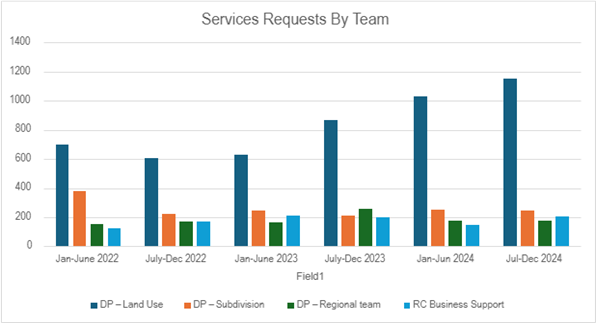
5.2 As
of February 2025, the open service request enquiries across the resource
consent section are at 99. Given our reduced staff level, especially in the
land use consents team it has been a challenge to reduce this overall number.
5.3 We
need to be very mindful that consent planners need to prioritise consent
processing, as these are bound by legislative statutory timeframes and
penalties.
5.4 During
this reporting period we responded to 54 LGOIMA requests in resource consents
to provide information on. The last reporting period we responded to 45.
6. Notified, Hearings and Appeals
6.1 During
this reporting period we are still working on the same appeal and there have
been no new appeals. This is outlined in table 5 below. We also have been
working on a number of hearings that are being planned/booked or confirmed for
the next 6 months. We have booked a number of hearings, but these could be
subject to change. These are outlined in tables 6 and 7.
Table 5:
Appeal in progress
|
Application
|
Status
|
|
Application by CJ Industries Limited for gravel
extraction at Peach Island, Motueka
(RM200488 and others).
|
The hearing took place over five days between 23 –
27 September 2024.
The judge directed the appellant to file a final set of
revised conditions and draft management plans by 25 October 2024.
The respondent (TDC) and s274 parties were directed to
file closing legal submissions by 22 November 2024, with the
appellant’s required by 18 December 2024.
We are now awaiting an interim decision, and that can be
expected around March – April 2025.
|
Table 6: Hearings in
Progress or Confirmed
|
Application
|
Status
|
|
Application by Chandrakirti Trust, for a retreat
center at Central Road South, Lower Moutere
|
A land use consent to establish and operate a
retreat centre (as a community activity) with 12 dwellings in the Rural 1 and
Rural 2 Zones.
The application was limited notified 15 January 2024 and
submissions closed on 13 February 2024. Two submissions were received, both
opposing the application.
The hearing was held and adjourned on 11 October 2024. The
commissioner issued minute #1 directing the provision of further information
from the Council’s ecologist in relation to wetlands and from the
applicant in relation to FENZ matters, and then from the Council’s
processing planner in relation to an addendum to the hearing report covering
both of those issues. Those matters were addressed, which then led the
commissioner to issue minute #2 requiring an updated site plan and directing
the applicant to apply for another resource consent under the National
Environmental Standards for Freshwater for the damming and use of water
within 100m of a wetland. This is still outstanding.
|
|
Application
|
Status
|
|
Application by Mapua Community Boat Ramp Trust, for
a new boat ramp and community building at Tahi Street, Mapua
(RM230253 and others)
|
The construction and operation of a new boat ramp
within the coastal marine area and foreshore, with access from the Māpua
Waterfront Park and associated consents for access and parking on the western
side of Tahi Street, signage, stormwater discharge and earthworks.
The application was publicly notified on 24 January 2024
and submissions closed on 26 February 2024. A total of 328 submissions were
received, with 30% opposed. Originally 88 submitters wanted to be heard, that
subsequently reduced to 50.
The application was suspended at the request of the
applicant so they could address some of the matters raised in the submissions
prior to the hearing, which included the following changes:
· Complete
removal of the proposed sea scout / community building from the application.
· Retaining
the existing carparking area within the waterfront park, with minor changes
to the layout to allow for the boat ramp access.
· Removal
of the formed car parking on the western side of Tahi Street.
· The
proposed grassed trailer parking area is unchanged.
· The
proposed boat ramp is largely unchanged except that the kerbing on the
southern side of the proposed access will have cut drains into the swale
instead of sumps and piped outlets (reducing the amount of trenching
required).
· The removal
of the buildings and retention of the existing carparking area
significantly reduces the amount and depth of earthworks required
on a HAIL site.
More details of the amended proposal can be found on
Council’s website via the following link: Māpua Community Boat Ramp Trust | Tasman District Council.
A hearing was held by Commissioners on 25-27 November and
9-10 December, during which the applicant and 50 submitters were heard plus
technical experts.
The hearing was adjourned to give the applicant an
opportunity to provide further information relating to contaminants in the
foreshore area that would be disturbed by construction of the proposed boat
ramp, and how the ramp will be constructed. That further information is due
by 14 April 2025.
|
Table 7: Hearings to be
booked
|
Application
|
Status
|
|
Application by Ruru Building Ltd, for a tiny home
factory at 54 Green Lane, Motueka
(RM210785 and others)
|
The establishment and operation of a tiny home building
factory under the northern flight approach to and breaching the obstacle
limitation surface the Motueka Aerodrome and on productive land.
The application was publicly notified on 19 April 2023 and
submissions closed on 19 May 2024. A total of 208 submissions received, and
55 wanted to be heard.
These applications are effectively on-hold while waiting
for the Applicant to confirm they wish to proceed to a hearing, and in turn,
pay the base deposit fee before the necessary arrangements can be made in
that regard.
|
|
Application by D Tipple & T Tipple & M Tipple,
for a private deck and stairs in the road reserve and 38 Kaiteriteri-Sandy
Bay Road, Kaiteriteri
(RM240000)
|
Retrospective land use consent for a private deck and
stairs that has been constructed partially on the coastline road reserve,
breaching boundary setbacks, and located in the Coastal Environment Area
(CEA).
The application was publicly notified on 27 November 2024
and submissions closed 29 January 2025. A total of 14 submissions were
received, all opposing, with six wanting to be heard.
This application is effectively on-hold until the
applicant confirms they wish to proceed to a hearing and pay the base deposit
fee before the necessary arrangements can be made.
If needed, this will be an independent commissioner
hearing due to direct Council interest in the road reserve.
|
|
Application by Adcock Properties Ltd, to cancel and
change conditions of consent RM100848 in to the establishment and operation
of the Motorsport Park (Kohatu Park) in the Rural 2 Zone, at Motueka Valley
Highway, Tapawera
(RM100848V1)
|
Resource consent was granted in June 2012 for the Kohatu
Motorsport Park. This consent went through a notification process and hearing
that resulted in a consent being granted with a number of conditions. This
consent was subsequently appealed by some submitters to the Environment Court
and a consent order was issued on 20 March 2014 that altered some of the
original conditions.
The applicant is now proposing to cancel and change
conditions 1, 2, 8, 11, 13, 16, 17, 18, 22, 28, 30, 30, and 44, because the
motorsport park development has not progressed at the speed originally
expected and the conditions should reflect and provide for that progression.
The application was limited notified on 3 December 2024
and submissions closed on 22 January 2025. A total of four submissions were
received, all opposing some or all aspects, and all wanting to be heard.
This application is effectively on-hold until the
applicant confirms they wish to proceed to a hearing and pay the base deposit
fee before the necessary arrangements can be made.
A willing and able independent commissioner has also been
found.
|
|
Application by Gion Deplazes and Heidrun Berl, to
subdivide and develop 31 Greenhill Road, Ngatimoti
(RM240006 and RM240007)
|
A combined subdivision and land use consent to create four
new allotments, construct generic dwellings on three of them that breach
internal and road boundary setbacks, and to waive an esplanade reserve
requirement along an unnamed stream, in the Rural 1 and Rural 2 Zones.
The application was limited notified on 14 January 2025
and submissions closed on 12 February 2025. A total of three submissions were
received, all opposing and wanting to be heard.
This application is effectively on-hold as the applicant
attempts to resolve matters with the submitters or confirms they wish to
proceed to a hearing and pay the base deposit fee before the necessary
arrangements can be made.
A willing and able independent commissioner has also been
found.
|
|
Application by Te Koi Holdings Ltd, for a
subdivision to create three allotments at 133 Bronte Road East, Upper Moutere
(RM220699 and Ors)
|
A combined subdivision and land use consent to create
three new allotments, construct generic dwellings on two of them that breach
internal boundary setbacks and are within the Coastal Environment Area,
including associated discharge permits for stormwater and treated domestic
wastewater, in the Rural 3 Zone.
The application was limited notified on 20 December 2024
and submissions closed on 10 February 2025. One submission was received in
opposition.
This application is effectively on-hold until the
applicant confirms they wish to proceed to a hearing and pay the base deposit
fee before the necessary arrangements can be made.
Potential commissioners are being sounded out.
|
7. Water permit applications / objections
7.1 Tākaka
(Water Management) Zone: Regarding the seven applications for new
irrigation use, these continue to be on-hold as they are subject to the
provisions of the Te Puna Waiora o Te Waikoropupū Springs and Wharepapa
Arthur Marble Aquifer Water Conservation Order (WCO) and the NES Freshwater.
7.2 Waimea
(water management) Zone: The Waimea East Irrigation Company (WEICo) (s357)
objection to decisions RM170207 - RM170208 has been resolved without need for a
hearing.
Outstanding Waimea
objections (s357) are as follows:
· Consents staff
understand Redwood Valley Irrigators (RVI) and Waimea Irrigators Limited (WIL)
are continuing to discuss the conditions of the Irrigation (Scheme) Shareholder
Water Augmentation Agreement (ISWAA) and positive progress is being made.
Council staff are regularly in contact with WIL; and
· Relating to one
applicant, there is one outstanding complex (Reservoir Zone) objection relating
to an affiliated consent (and three related objections to damming, excavation
of gravel seepage holes etc) in this Waimea zone of benefit (S124 applies); and
· one outstanding
complex (Waimea West Zone) objection relating to an unaffiliated consent.
Twelve applications relating to
a joint allocation sharing framework (involving multiple affiliated permits
& holders and one unaffiliated permit holder) are on hold pending the
results of a current review of Councils Tasman Resource Management Plan (TRMP)
support for allocation sharing, now the Waimea Community Dam is fully
operational.
7.3 Redwood
Zone: Five objections relating to the TRMP rezoning of the zone of benefit
(for the Waimea Dam) are still outstanding. Their argument about the change to
the water zoning is considered by Council staff to be outside the scope of the
consenting process. However, while the objections have not been withdrawn,
consent staff understand none of the Objectors want to take this issue to a
hearing.
7.4 Upper
Motueka: Two objections relating to the 2017 bona fide assessments,
which reduced the water allocations in the replacement consents, are yet to be
resolved. These objections are top priority for action following the
current irrigation/harvesting season.
7.5 It
is noted that consent holders who have unresolved Objections on their
replacement water consents can continue to operate in accordance with the
provisions of their old consents as allowed under section 124 of the RMA.
8. Other
notable applications and process work
8.1 Coastal
Permits for Marine Farms update:
8.2 The
Resource Management (Extended Duration of Coastal Permits for Marine Farms)
came into force on 3 September 2024. This Required Councils to extend the
duration of all RMA coastal permits that enable marine farms to operate by 20
years (in addition to their current term), but not beyond 31 December 2050.
Council had six months to update all marine farming permits.
8.3 We
have completed updating the expiry date for all the marine farming consents and
associated discharges.
8.4 For
Tasman this pushes all the existing marine farming permits to expire on the 31
December 2050 except for the following:
8.4.1 Eight
(8) Wainui Bay consents expiring 31 December 2044
8.4.2 One
(1) AMA 1 consent expiring 31 December 2044
9.1 We
are continuing to send the list of applications received weekly out to iwi,
along with them being able to access the live list on our website. We are also
exploring options to improve the way we engage with iwi as part of the consent
process more generally.
9.2 As
consenting matters arise, we discuss these with the Councils Kaihautū team
and we meet regularly on a monthly basis to ensure consistency and
understanding across all areas.
10. Current staffing, contractors, and workload
10.1 Advertising
for staff, working with recruitment agencies, and accessing our networks has
been constant, as we seek to find and employ experienced planning staff. Since
the last reporting period we had one new start and two resignations.
10.2 We
have recruited successfully for a consent planner in the land use team and we
are currently interviewing for a Development Engineering Officer.
10.3 The
two resignations were a senior planner in the land use team and a consent
planner in the subdivisions team. The senior has decided to pursue a career
change, and the consent planner who came to Tasman as a graduate and has been
here for 3 years has decided to travel the world.
10.4 Once
again this reporting period we have seen a reduction in the cost of using
external contractors to process consents. We have been working hard to secure
contractors that can add value to our processing and are affordable in the
context of approved charge out rates.
11. Government Initiatives Update
11.1 The
Resource Management (Consenting and Other System Changes) Amendment Bill, often
referred to as RMA Bill 2, introduces several changes. Overall, the
effect of the changes is unlikely to be significant to consenting in Tasman.
However, the final wording will be key.
11.1.1 Infrastructure
and Energy: The bill sets default maximum time frames for consent
processing and establishes default consent durations for renewable energy and
infrastructure projects.
11.1.2 Farming
and Primary Sector: The bill clarifies the interface between the RMA and
the Fisheries Act, improves the certification and auditing of farm plans, and
aims for timely consent processing for wood processing facilities (1-year total
time).
11.1.3 Natural
Hazards and Emergencies: It provides additional tools to deal with natural
hazards and emergency events. It allows us to examine the hazard risk as part
of processing a land use consent.
11.1.4 Compliance:
The bill starts to implement the enforcement provisions of the NBEA.
11.1.5 National
Planning Standards: These will be further developed to provide consistency
across planning documents, with the aim to make it easier to navigate rules and
regulations.
11.1.6 Urban
Development Authorities: These are introduced to facilitate large-scale
urban development projects, providing a streamlined consenting process for
certain projects deemed nationally significant.
11.1.7 Environmental
Outcomes: The focus is shifted towards achieving better environmental
outcomes while balancing economic and social considerations.
These changes are designed to
make the resource consent process more efficient and transparent, while
ensuring robust environmental management practices are maintained.
12. Process
improvement work
12.1 The
team has had support from other sections in the Council to assess where our team
needs assistance in implementing process improvements. This is an ongoing
project that the section will keep working on but will ensure that all parts of
the Council that have inter-dependencies with the Consents Section are aware of
the impact their prioritisation decisions on the consenting process.
12.2 During
this reporting period and into the next 6-12months we have been working on
particular process improvements. Examples are outlined in Table 8 below.
Table 8:
Types of improvements and progress
|
Type/Purpose
|
Progress
|
|
Circulation Workflow Tool/Platform
Circulating resource consents in a more efficient and
effective way around departments for comments.
|
Over this period we have made progress with the
circulation tool, called ReCon. The Information Services team has committed
to developing and supporting this project. During the past month we have been
testing the tool and plan to complete wider testing with the contributors
soon. The plan is to go live end of March.
Ultimately this tool is about improving the timeframes and
information transparency when contributors across Council comment on a
resource consent. There are 13 areas that can be asked to comment on
resource consents.
|
|
Contractors
Reviewing our contracts and scope of services details to
be consistent across all contracts.
|
We currently have several contractors across our three
teams assisting with processing resource consents. The scope of services of
these contracts is being reviewed and we will be progressing through a
procurement process.
|
|
Process Mapping
Commencing an overview of our current processes and
mapping how and why we do things the way we do.
|
Resource consents have a number of processes with
processes within processes on how we ensure a consistent way of processing a
resource consent and a fair and reasonable decision outcome for all.
We have finalised the mapping of these processes over this
reporting period. We have identified the top priorities and the
identified improvements where we need additional support to make it happen.
|
|
Management of costing disputes
The purpose here is to improve how we manage any costing
disputes.
|
As a resource consents section we receive around, on
average a year, one costing dispute per week. These can take up a lot
of staff time and energy. We manage these through a spreadsheet, but we
are working on improving the efficiencies and transparencies in this area for
both Council staff and the consent holder/applicant.
|
Nil
Environment and
Regulatory Committee Agenda – 11 March 2025
7.6 Rivers and Coastal Structures
Information Only - No Decision
Required
|
Report
To:
|
Environment
and Regulatory Committee
|
|
Meeting
Date:
|
11
March 2025
|
|
Report
Author:
|
David
Arseneau, Team Leader Rivers & Coastal Structures
|
|
Report
Authorisers:
|
Rob
Smith, Group Manager - Environmental Science
|
|
Report
Number:
|
RRC25-03-6
|
1. Summary
/ Te Tuhinga Whakarāpoto
1.1 The
relatively calm and settled weather has continued since July 2024, barring some
localised minor freshes in the spring, allowing important maintenance work to
continue in many of our rivers.
1.2 The
next phase of refurbishment on the Motueka Stopbanks has commenced, with
Taylors breaking ground in February 2025. This significant programme of capital
works, part of the Government’s Regional Infrastructure Fund, will be
carried out over the next three years.
1.3 This
report covers a range of river and coastal operations over the past several
months to keep Council up to date on this dynamic area and provide clarity on
the work being undertaken to provide a more responsive and resilient service.
2. Recommendation/s
/ Ngā Tūtohunga
That the
Environment and Regulatory Committee
1. receives
the Rivers and Coastal Structures report RRC25-03-6.
3.1 This recurring Rivers and Coastal
Structures update report has a three-fold purpose:
3.1.1 To update the Environment and Regulatory
Committee on the activity in the Rivers and Coastal Structures team,
3.1.2 To receive feedback as to the
committee’s considered view of what good river and coastal management
operations looks like, and
3.1.3 To provide a
level of confidence as we change and adapt to the new operating and legislative
environment around us, that we have a plan and are focused in the right
direction.
4. Operational Work Programme Achievements and Forecast
4.1 For
this report period, Taylors Contracting has been undertaking river works
primarily in the Upper Motueka River, with rock protection placed in areas that
were damaged in the October 2024 minor flood, with some channel clearance and
vegetation maintenance in the Riuwaka River and Hamilton’s and
Scott’s Drains.
4.2 Other
river related maintenance activity during this period included native planting
maintenance, stopbank mowing, rubbish collection and both monthly and
six-monthly outfall inspections.
4.3 A
short summary of the month-to-month work completed since the previous Rivers
update report is included below.
4.3.1 November
2024 works (36 jobs):
· Rock Protection
– Upper Motueka River
· Willow Planting
– Upper Motueka River
· Native Plant
Maintenance – Lower Motueka, Moutere and Waimea Rivers
· Monthly Outfall
Inspections
· Illegal Dumping
Removal – Lower Motueka and Waimea Rivers
4.3.2 December
2024 works (23 jobs):
· Flood Management
and preparation for channel fairway widening – Upper Motueka River
· Native Plant
Maintenance – Lower Motueka River
· Vegetation
Clearance – Hamilton’s and Scott’s Drains
· Monthly Outfall
Inspections
· Illegal Dumping
Removal – Wairoa River
· Stopbank Mowing
4.3.3 January
2025 works (53 jobs):
· Native Plant
Maintenance – Lower Motueka River
· Native Planting
Site Preparation – Lower Motueka River
· Fairway Spraying
– Motupiko and Wai-iti Rivers
· Mechanical
Mulching – Riuwaka River
· Six-Monthly
Outfall Inspections
· Illegal Dumping
Removal – Lee, Wai-iti and Wairoa Rivers
· Waimea Stopbank
top mowing
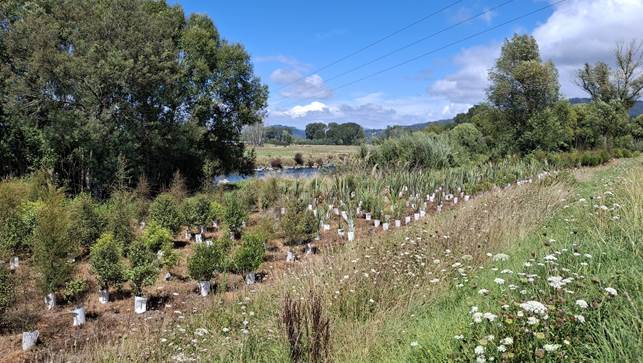
Figure
1: Maintenance
of native planting site near Blue Gum Corner
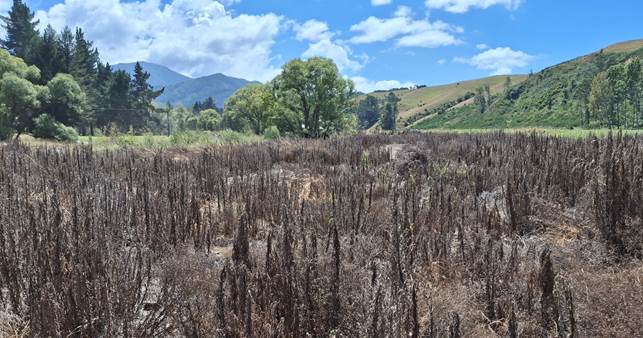
Figure
2: Preparation
of future native planting site at Pokororo; the contractor begins preparation
of each site by spraying off invasive weeds, starting up to a year in advance
of planting.
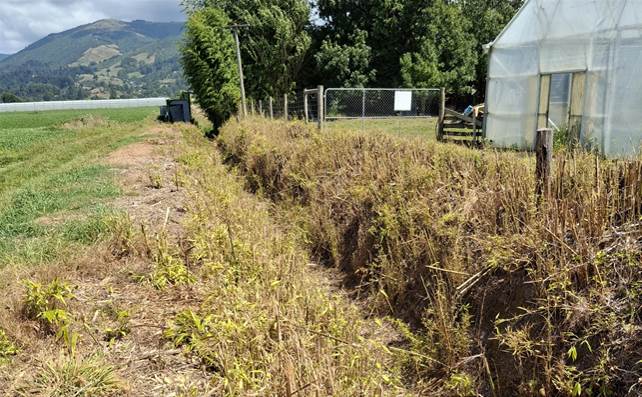
Figure
3: Clearing
along Hamiton’s Drain, removing an extensive growth of invasive bamboo;
we will need to keep up a programme of regular spraying and clearance to ensure
the bamboo does not reestablish and re-block the drain.
5. Gravel Management Update
5.1 The
pace of gravel extraction has begun to pick up over the past several months,
with approximately 12,000 m3 extracted since November 2024.
Extractions in several key rivers have been limited over the summer months due
to breeding bird restrictions, but the Rivers Team have identified a range of
future extraction sites that have been permitted or are in planning.
5.2 Total
gravel extraction volumes from 1st July 2024 to 31st January 2025 (i.e., a
running total for the current financial year) are summarised in the table
below, along with the team’s estimate of future extractions that are
either permitted or in active planning. It is expected that the
planned/permitted extractions will occur before the end of the financial year.
|
River / Stream
|
Gravel Extracted
(m3)
|
Additional
Gravel Planned/Permitted for
Extraction (m3)
|
|
Anatoki River
|
697
|
|
|
Buller River
|
172
|
|
|
Matakitaki River
|
0
|
~6,000
|
|
Motueka River – Lower (MBLE)
|
7,536
|
|
|
Motueka River – Middle
|
0
|
|
|
Motueka River – Upper (MBLE)
|
6,039
|
22,000
|
|
Motupiko River Total (MBLE)
|
0
|
|
|
Tākaka River
|
1,943
|
~8,000
|
|
Wai-iti River
|
0
|
~2,500
|
|
Waimea River (MBLE)
|
0
|
|
|
Riuwaka River
|
0
|
|
|
Smaller Rivers and Tributaries
|
184
|
|
|
Grand Total
|
16,571
|
38,500
|
5.3 The
reduced gravel extraction fee remains in effect for the Upper Motueka River, as
reported to Council in the 10 October 2024 meeting Environment and Regulatory
Committee, RRC24-10-2. We expect to review the need for this reduced rate at
the start of the next financial year.
5.4 Photos
of extractions that are either permitted or recently completed are shown below.
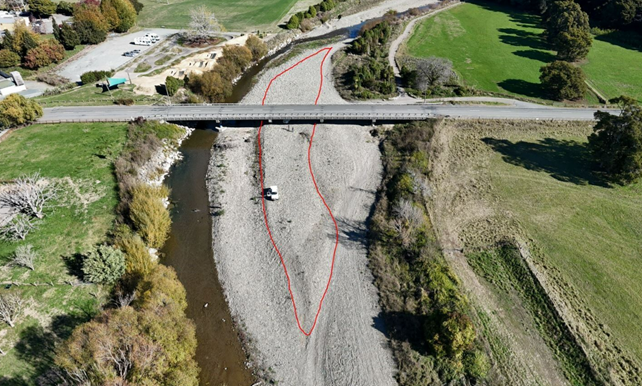
Figure
4: Permitted
gravel extraction at Pigeon Valley Bridge Road (accumulated area outlined in
red) – extraction will be undertaken by Tasman Alliance to support
Council’s roading programme.
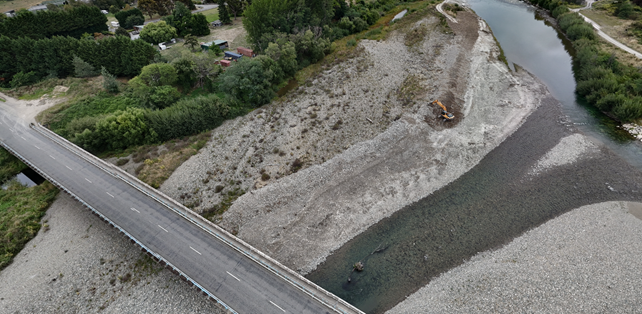
Figure
5: Gravel
extraction underway at the Tadmor Valley Road bridge.
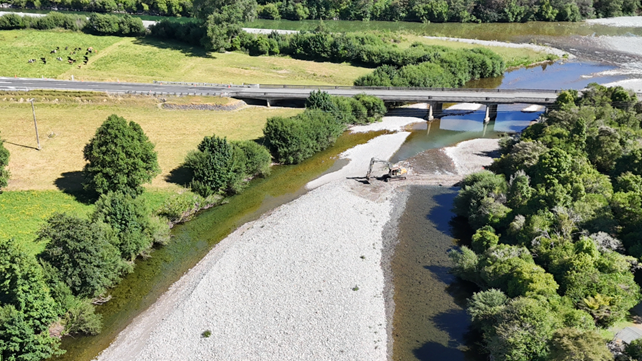
Figure
6: Gravel
extraction at Paynes Ford on the Tākaka River started in December 2024
(commencement shown above) but was paused before the holidays to avoid the busy
tourist season at the adjacent DOC reserve.
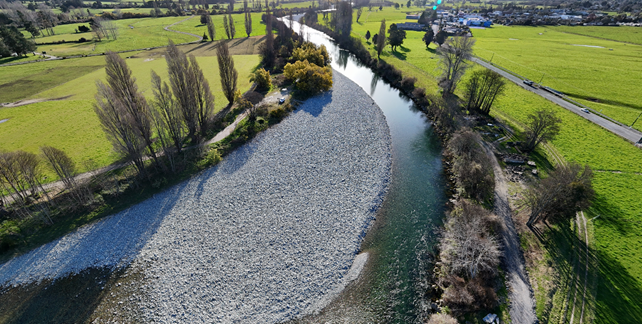
Figure
7: An
extraction of up to 5,000 m3 has been permitted for “McKenzie’s
Beach”, opposite McKenzie’s Bank on the Tākaka River.
6. Tasman District Council Nursery Update
6.1 The
Rivers Team retained CW Drilling and Water Force Ltd to complete the
installation of a new water bore at the Council Nursery, finished in November
2024, which is now providing a consistent supply of water. Assessment of the
existing bore pump indicates the pump still has life in it, yet it is something
we will keep an eye on.
6.2 This
summer period has seen several water leaks on the nursery irrigation lines,
which are becoming more frequent. However, despite the number of leaks this
summer, this did not create great issues because of the relatively wet summer
weather, leading to excellent growth in the nursery.
6.3 November
and December 2024 saw Council and Taylors staff undertake a stocktake of total
trees in the nursery, and an estimate of how many poles we expect to harvest in
2025. As of Summer 2024-2025, there are a total of 7,557 trees in the nursery,
with 4,352 poplar and 3,205 willow trees. Many of these trees are not mature
enough yet to produce poles but are expected to reach that stage in 2026. We
expect to harvest approximately 1,750 poplar poles this winter, which is in
line with previous harvest years, and approximately 3,400 willow poles and
stakes (smaller than poles), which is an increase on previous years.
6.4 In
planning for this year’s harvest, we have allocated the entire poplar
yield to our neighbours Marlborough District Council and Nelson City Council.
Tasman District Council has an existing agreement with Marlborough District
Council to endeavour to provide 1,500 poplar poles each year, in exchange for a
substantial investment in the nursery made several years ago. We are currently
in discussions with Nelson City Council staff for a similar arrangement. Some
willow material will be made available to the public; however, the majority of
willow material will support our river management programme. This will be the
first time for several years that poplar material is not available to the
public. We expect distribution to the public to resume in 2026 with the
expectation that trees planted in recent years will begin to produce poles by
that time.
6.5 We
are currently developing a nursery management and expansion plan that includes
assessment of the existing infrastructure at the site, and the potential to
expand into adjacent Council-owned river berm to increase our ability supply
our neighbour councils, our river management programme, and the general public.
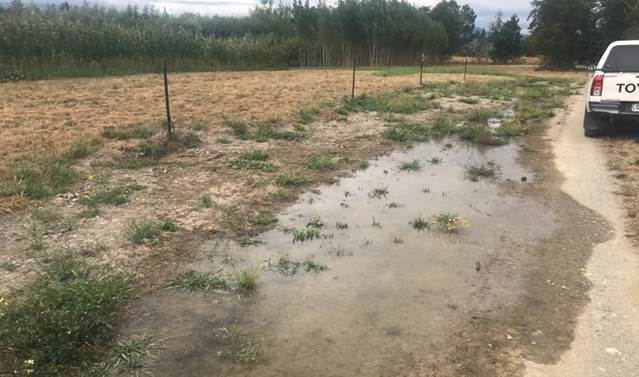
Figure
8: Ponding
water at the nursery from broken irrigation pipes.
Figure
9: Failed bore
pipe at nursery (left) and installation of new irrigation bore (right).
7. River Management Issues and Initiatives
OAG Performance Audit – Flood Protection
7.1 Tasman
District Council, alongside Waikato Regional Council, has been selected by the
Office of the Auditor-General (OAG) to participate in a performance audit on
flood protection infrastructure. The OAG’s focus for the performance
audit is on how well Tasman District Council as a local authority ensures that
flood protection infrastructure effectively mitigates the risk of flooding from
rivers and inland bodies of water.
7.2 The
OAG team were on site in Tasman from 20-22 November to conduct in-person
interviews and site visits of our stopbank systems. Council staff have also
provided the auditors with a range of documents and reports on our flood
protection infrastructure and other general Council policies.
7.3 The
draft audit report is currently in development, and we expect to see a
preliminary/summary version in early March 2025 for our review.
Rivercare Meetings 2024
7.4 The
2024 Rivercare Meetings were carried out in November and December 2024, with
great turn out from the community and Councillors.
7.5 Feedback
received during and following the meetings has been positive and optimistic,
and the Rivers Team is committed to returning to the 2025 Rivercare Meetings
with plenty of progress to discuss with local ratepayers.
7.6 Minutes
from each meeting were prepared and distributed to all attendees who provided
contact information before the holidays. We are in the process of getting the
meeting information pamphlets and minutes posted to the Council website.
Retendering of the River Works and Maintenance Contract
7.7 The
new river maintenance contract, C1552, which will take over from the existing
contract, C1064 as of 1 July 2025, was issued for tender on 29 January 2025
with a closing date of 12 March 2025. Further information on the tender award
will be brought to a future tenders panel and Environment and Regulatory
Committee (ERC) meeting when the process has concluded.
Motueka and Peach Island Stopbank Project
7.8 The
construction tender for the next stage of stopbank refurbishment work closed on
6 November 2024, and Taylors Contracting was determined to be the preferred
contractor. The contract covers the full three-year period of stopbank
refurbishment work, running until June 2027.
7.9 Taylors
has broken ground on stopbank work in February 2025 on the first section of
refurbishment under the current funding package. Work will continue until the
end of the construction season, expected to be April or May 2025, and will then
restart as soon as possible in the spring.
Murchison River Management Area – Assessment of
Need
7.10 In
response to concerns from the Murchison and Districts Community Council and
others in the community, the RiversTeam commissioned an assessment of erosion
and geomorphology of the Buller and Matakitaki Rivers to inform the potential
creation of a new River Y management area around the town. Pattle Delamore
Partners Ltd (PDP) was retained to carry out this work, with the final report
received by Council in December 2024.
7.11 The
assessment noted that bank repairs at some of the identified erosion sites was
likely warranted. Under current policies/practices, that would require
landowner contribution under the River Z programme. The Rivers Team will
evaluate the feasibility of alternative approaches, such as the creation of a
new River Y area or a one-off Council intervention, and will bring a
recommendation to a future ERC meeting.
7.12 A
copy of the PDP assessment report is attached to this report (Attachment 1),
for reference/interest.
Fly-Tipping
7.13 Illegal
dumping along our rivers continues to be a chronic issue month to month, with
$13,698 spent since July 2024 to clean up and dispose of rubbish by the river
maintenance contractor. Aside from the cost of cleanup, which is covered by
Council’s waste management activity, the work occupies contractor time
and resources that should be focused on our rivers.
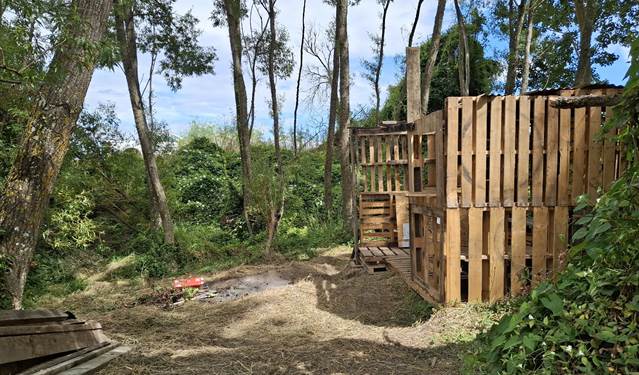
Figure
10: Pallet
hut, rubbish and burn pit that was removed from the Waimea River Berm in
January
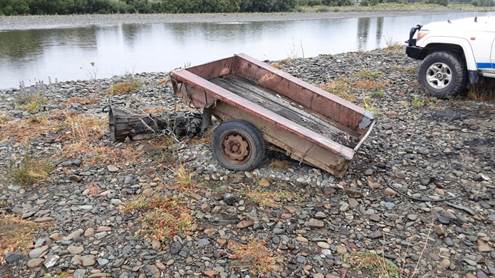
Figure
11: Trailer
and engine dumped on Waimea River berm by the Challies fishing ponds.
8. Coastal Structure Issues and Initiatives
Best Island Jetty
8.1 Following
a structural inspection of the jetty completed in November 2024, which found
the structure to be severely degraded, plans for removal of the structure were
initiated.
8.2 Local
Best Island residents were posted a letter on 22 January 2025 with a follow-up
email on 31 January 2025, detailing the situation, Council’s obligations
to ensure our coastal structures are safe, and the planned removal of the
jetty. Feedback received included: general understanding from most that the
structure is unsafe and needs to be removed; desire from some to lead community
funding and planning efforts for a replacement jetty (which we encourage and
will support); insistence from some that Council commit to a replacement
structure prior to removing the existing jetty; and one resident’s wish
to salvage the jetty sign as a keepsake (which was facilitated).
8.3 Contract
Worx were retained to complete the demolition work, which was carried out on
the morning of 24 February 2025.
8.4 There
is currently no budget allocated in the Long Term Plan for a replacement
structure, which would also require a resource consent to occupy the Coastal
Marine Area, but we will explore options with local residents and the Council
once the existing legacy structure is removed.
Figure
12: The Best
Island Jetty was removed on the morning of 24 February 2025.
Māpua Wharf
8.5 We
continue to see recurring minor maintenance issues at the Māpua Wharf
related to the existing deck boards, with nails coming loose, boards becoming
twisted and presenting a tripping hazard, and the surface becoming slippery in
some conditions. We will investigate costs and feasibility to renew the Wharf
decking and will present a case to Council as needed for budget.
Tasman District Council Coastal Assets.
8.6 Work
is ongoing to determine the ownership of the many coastal assets and what
structures the council is responsible for maintaining along our coastline. A
cross-Council working group meets regularly to collaborate on asset data
collation and verification, as well as on populating an interim asset database
solution while the longer-term permanent solution will be realised with future
horizons of Harakeke.
8.7 While
this project is underway, the Coastal Structures team will continue to carry
out regular asset condition inspections of key structures around the District.
9. Forward Work Programme
9.1 Construction
work on the Motueka Stopbank Refurbishment commenced in February 2025 and will
carry on until the end of the construction season.
9.2 We
have scheduled a range of river maintenance works over the next 4 to 6 months,
including the following:
· Aerial fairway
spraying for weeds occurring in March and April 2025 in the Upper Motueka and
Waimea Rivers
· Summer mowing of
Waimea, Motueka, and Riuwaka stopbanks in February 2024
· Stabilisation of
Eastern Hills Creek in Richmond in collaboration with the Stormwater activity
· Channel clearing
and vegetation management of Brooklyn River and Little Sydney Stream
· Channel clearing
and vegetation management of Powley Creek and the Company Ditch in the Moutere
River catchment
· Vegetation
management and bank stabilisation in Redwood Valley Stream and Eves Valley
Stream
· Tree removal and
stopbank repair along portions of the Waimea River stopbanks, to remove the
potential risk associated with piping along roots and bank damage from tree
toppling; this will be a multi-year programme due to the number of trees along
the stopbanks and the cost associated with removal and rebuilding of the bank
structure.
10.1 The
risk profile of Tasman’s flood protection stopbanks is important to
continually keep front of mind, shown in the table below. Standard best
practice would be a 1% AEP level of protection.
|
Stopbank Scheme
|
Level of Service standard
|
|
Waimea
|
2% AEP (1:50 year), with estimated 600mm freeboard
|
|
Motueka
|
2% AEP (1:50 year), with 50-600mm freeboard
|
|
Peach Island (not currently a formal LOS separate from
the Motueka LOS)
|
Generally, 2% AEP with variable freeboard, lowest at the
upstream/southern end of the island where there is little to no freeboard
|
|
Riuwaka
|
Less than 10% AEP (1:10 year)
|
|
Brooklyn (not a formal LOS)
|
Less than 10% AEP (1:10 year)
|
10.2 A
range of persistent risks exist in the Rivers and Coastal Structures
activities, and management of these risks is one of the primary tasks for our
team. We are starting work with the Assurance and Improvement Team to develop a
comprehensive risk register for the Environmental Science group and will
document the range of risks being managed in the Rivers and Coastal Structures
activities in that space.
11. Financial or Budgetary Implications
11.1 Our
focus for the 24/25 financial year has been important baseline maintenance that
has been delayed in previous years, including significant willow layering and
coppicing, management of excess willow material, willow and native plantings,
and localised rock repairs. Some smaller rain events in October and November
2024 have caused localised damage in the Upper Motueka and Tākaka
catchments that is being addressed by the Rivers Team.
11.2 Overall,
River activity expenditures are in line with budgets, with some minor
non-budgeted spend in the Coastal activity to address unsafe structures and
consent renewals.
11.3 Confirmation
of funding from Central Government for stopbank refurbishment has reduced
available river management capital budget on order to provide Council’s
co-pay for the funding, as planned for in the late stages of the Long Term
Plan. While this is a welcome injection of capital into our stopbank system, it
reduces our ability to address erosion damage in the river network if a larger
flood event occurs. So far this has not occurred, and the Rivers Team will keep
Council informed of any developments in this area.
|
1.⇩
|
Murchison
River Management Assessment - December 2024
|
90
|
Environment and
Regulatory Committee Agenda – 11 March 2025
